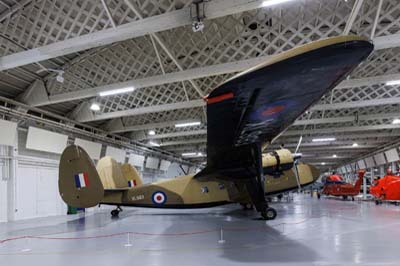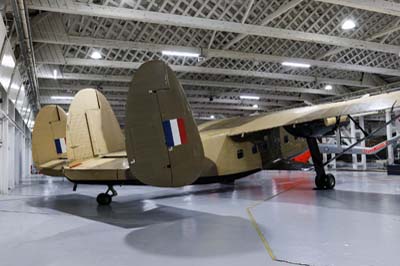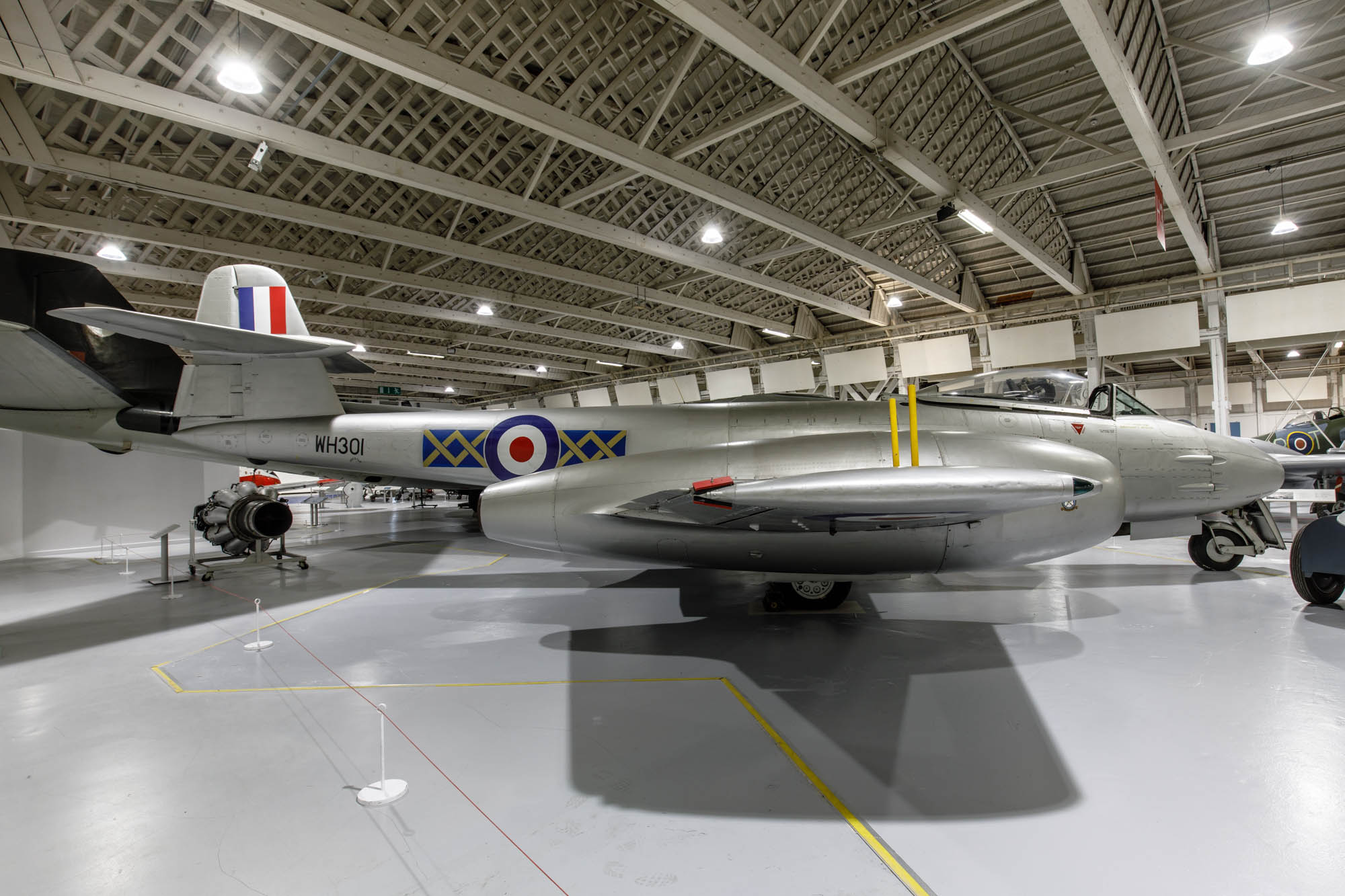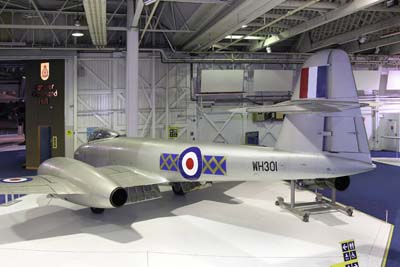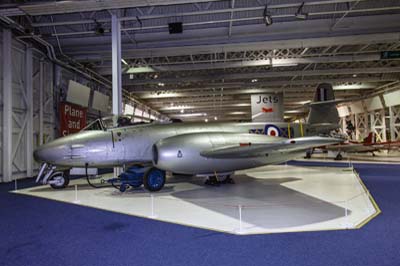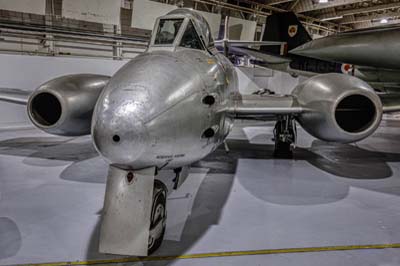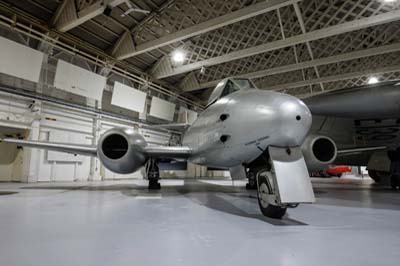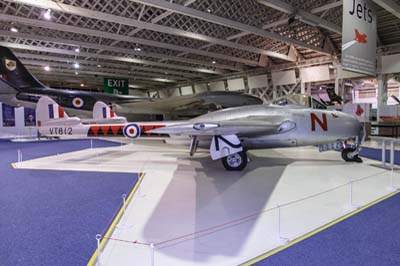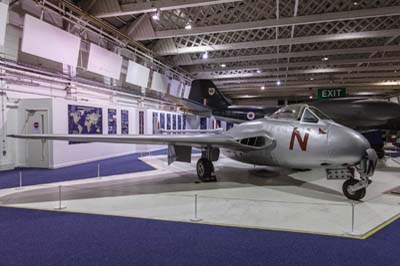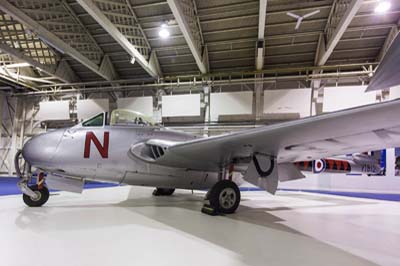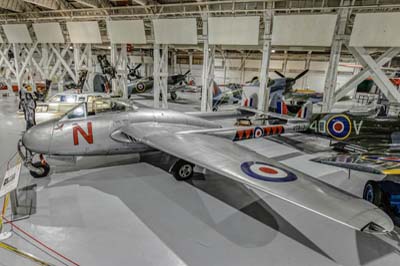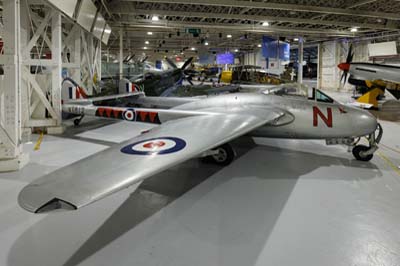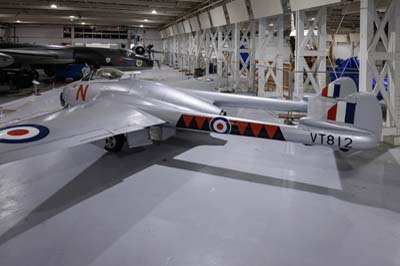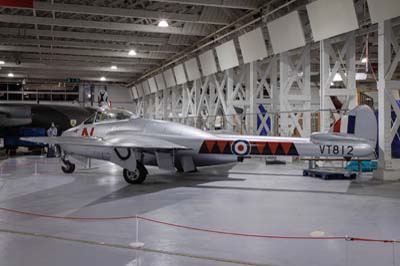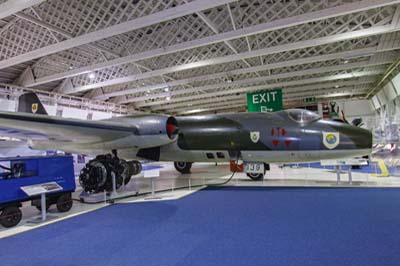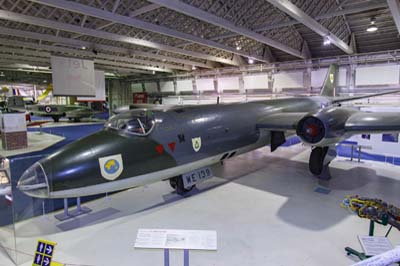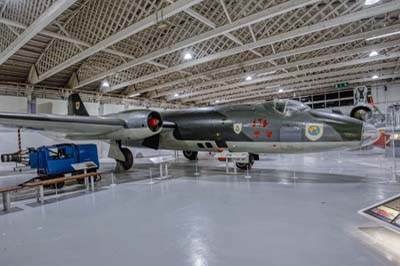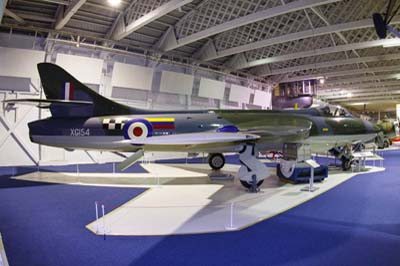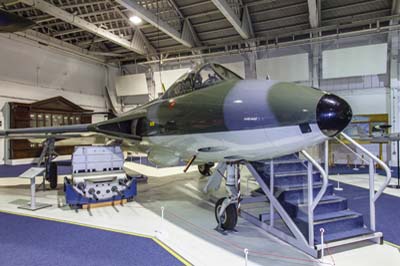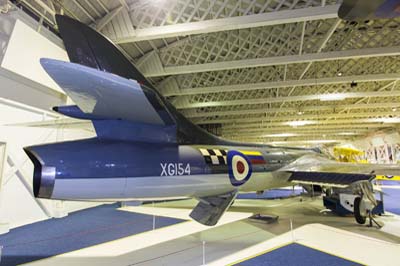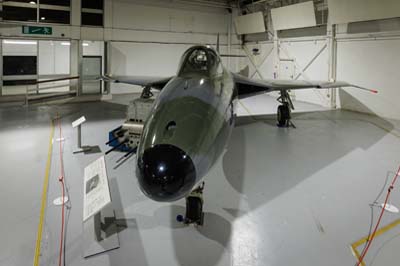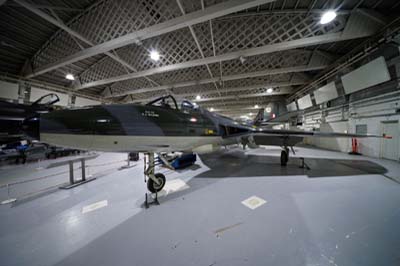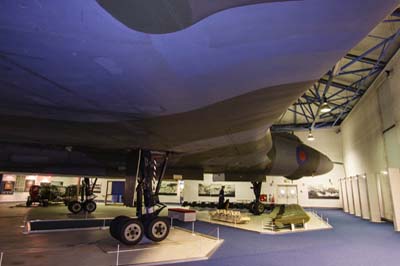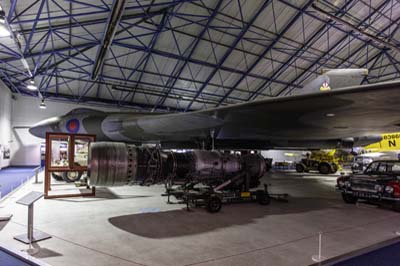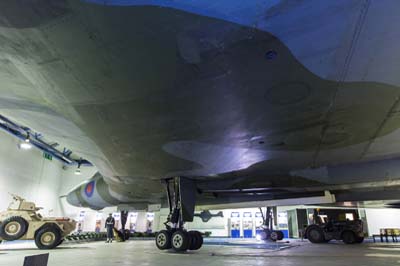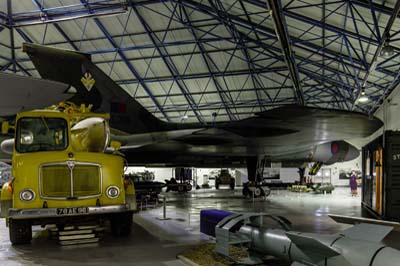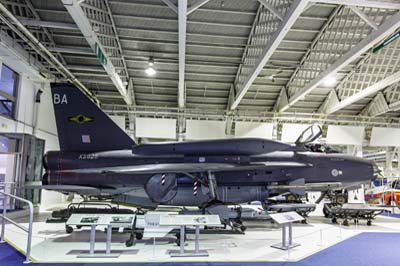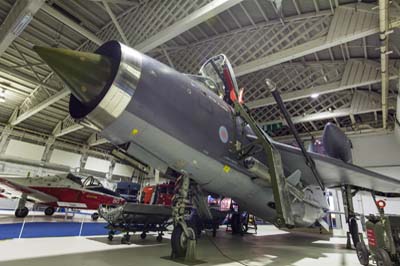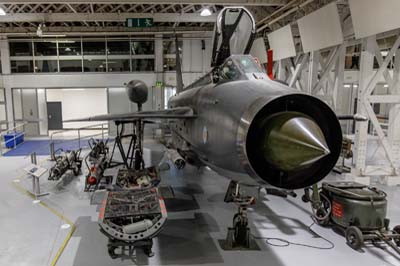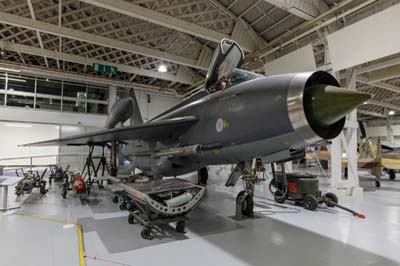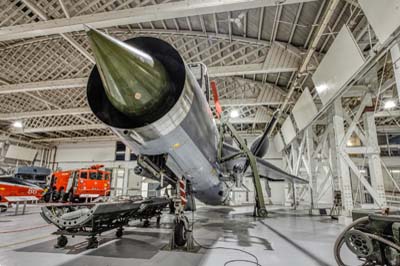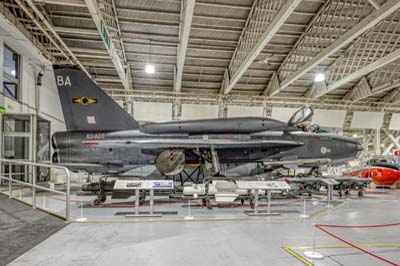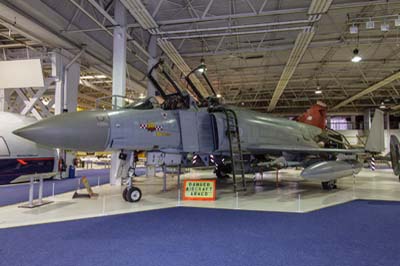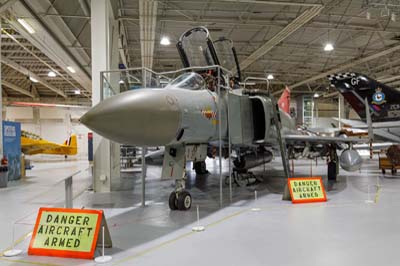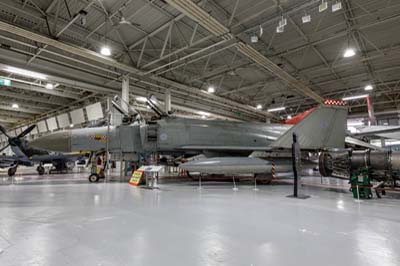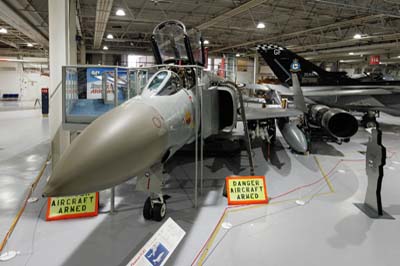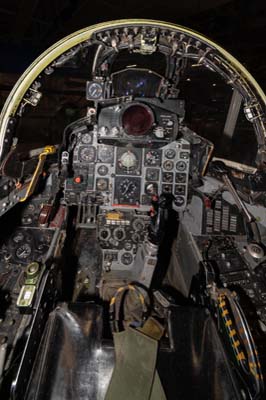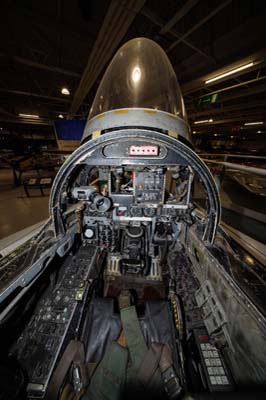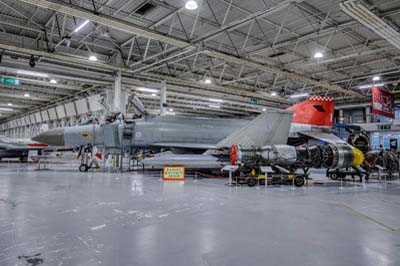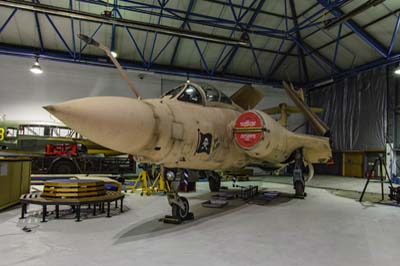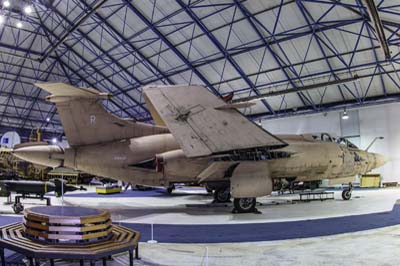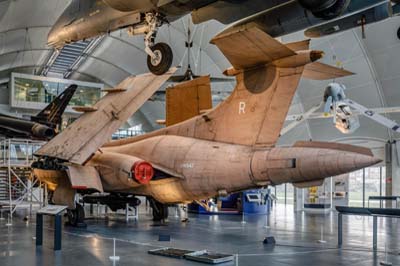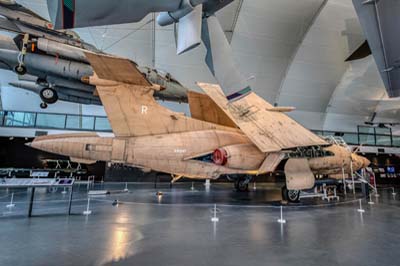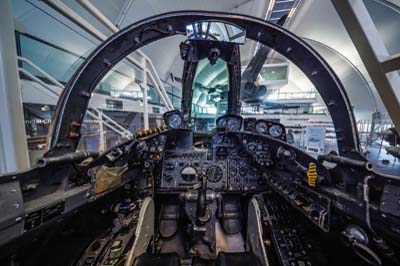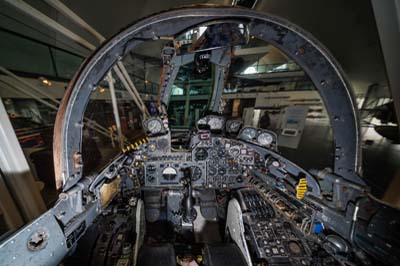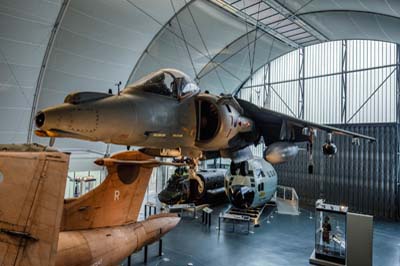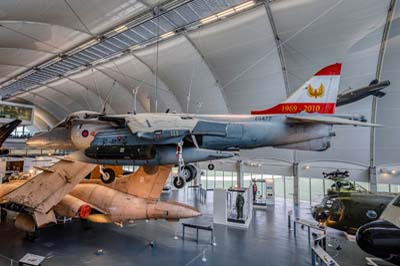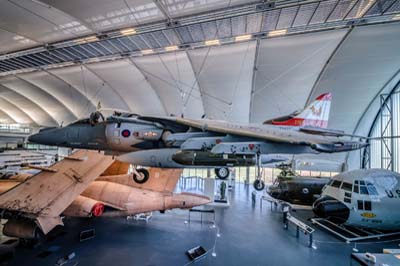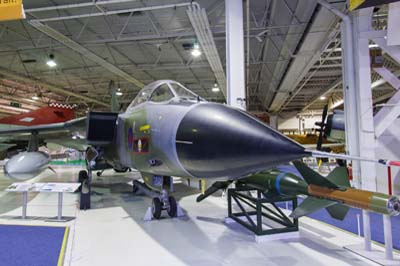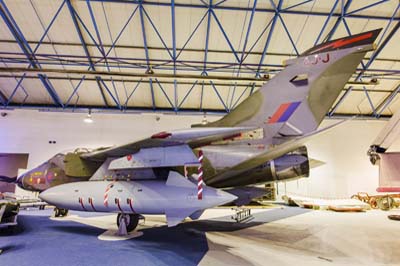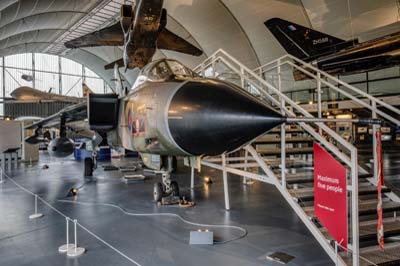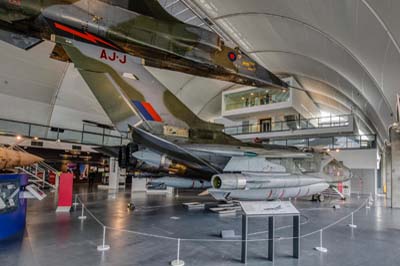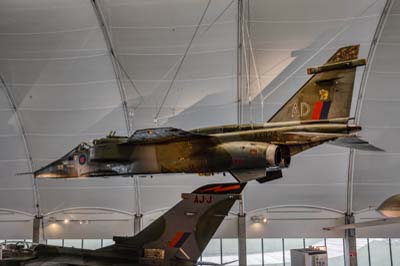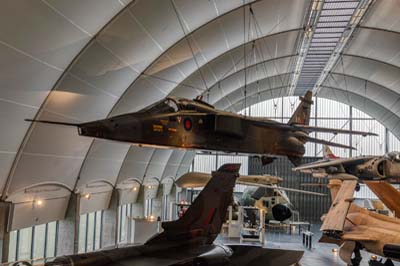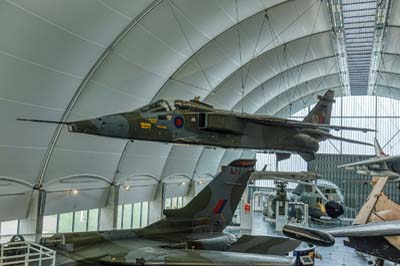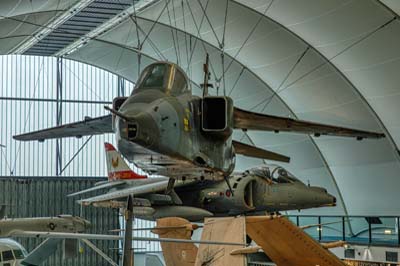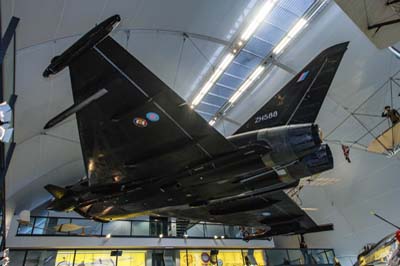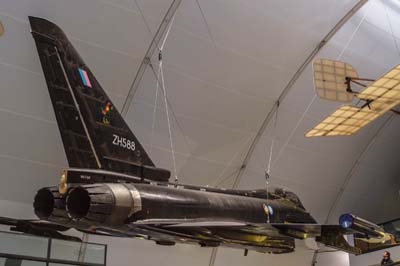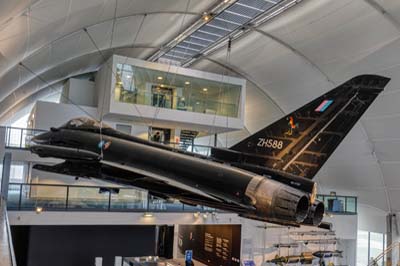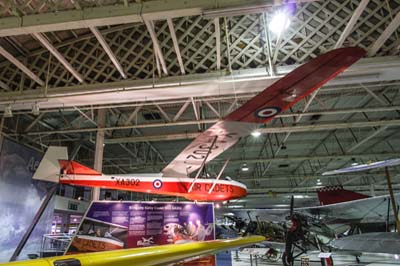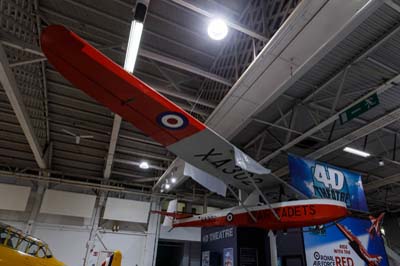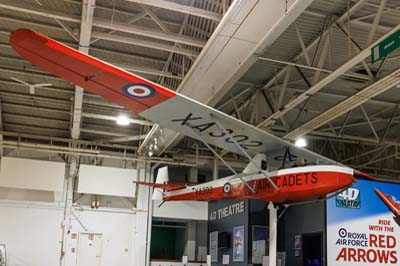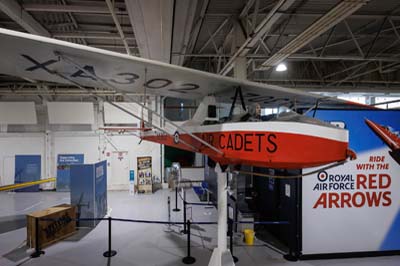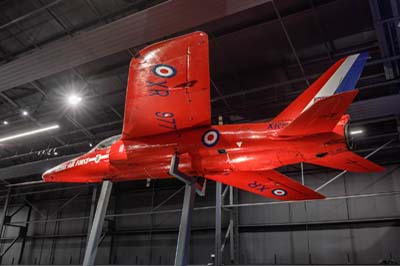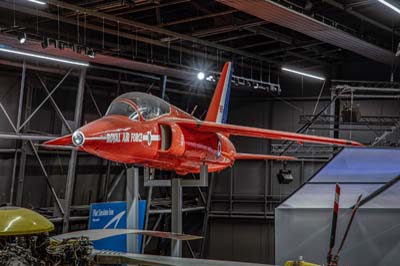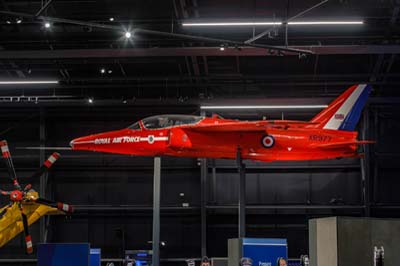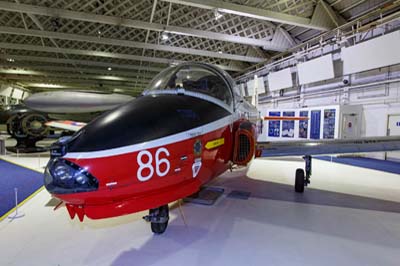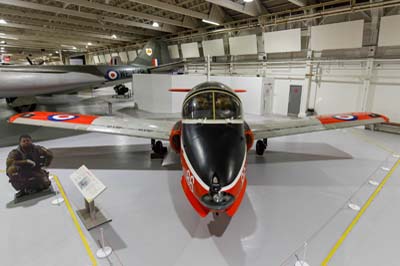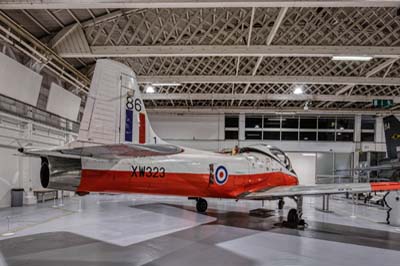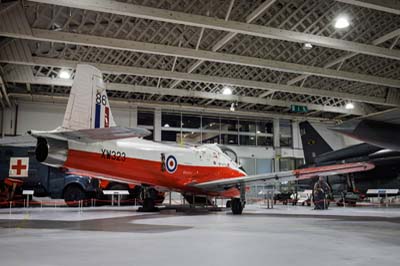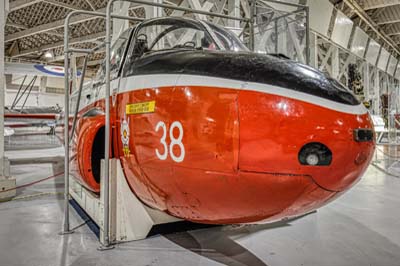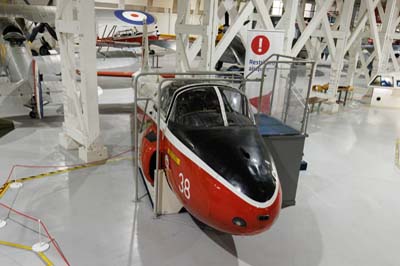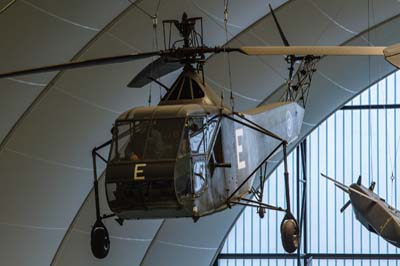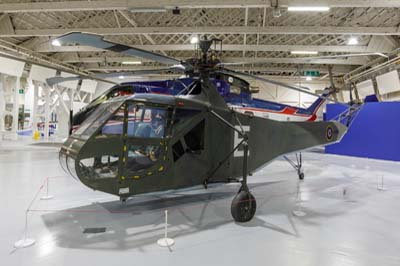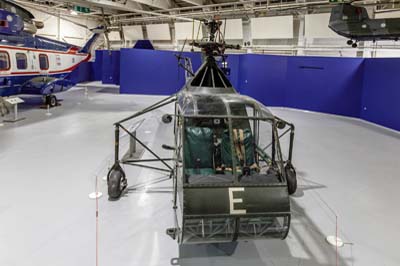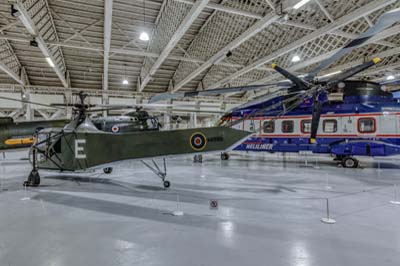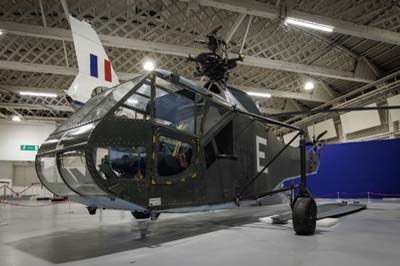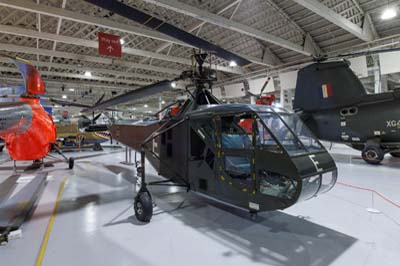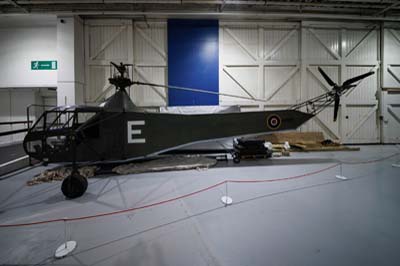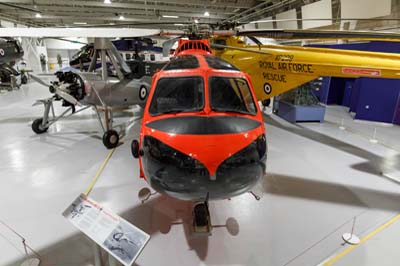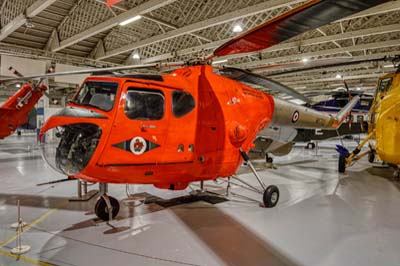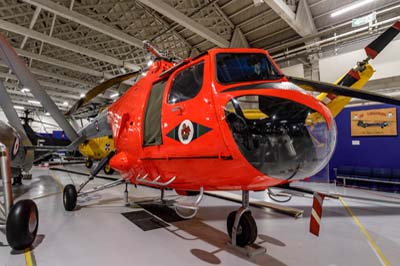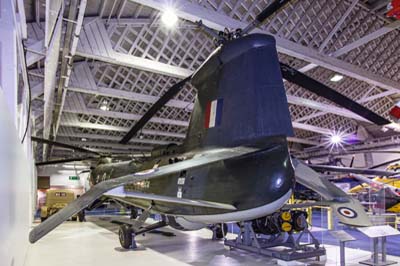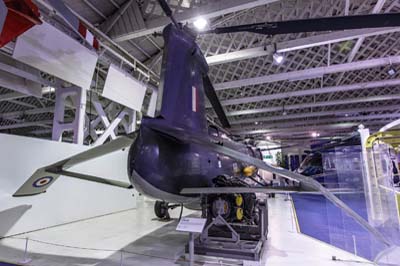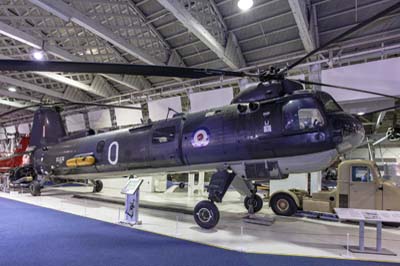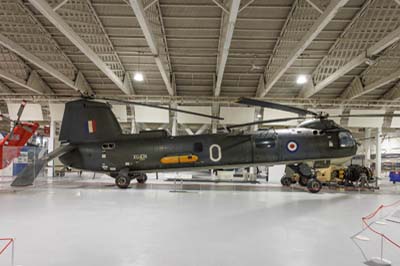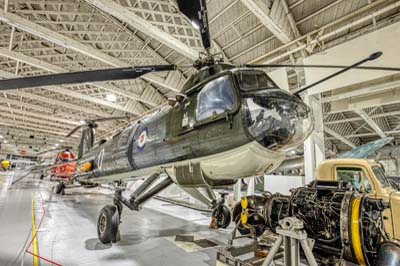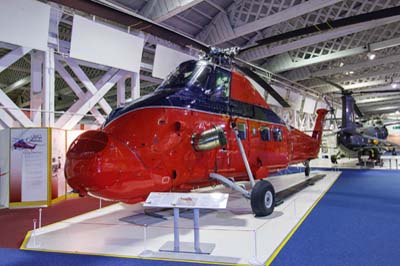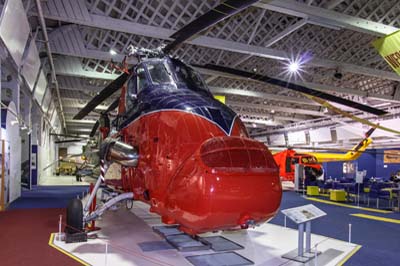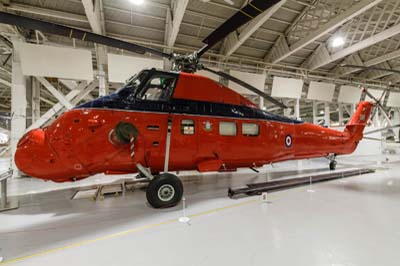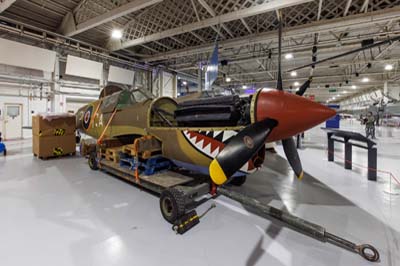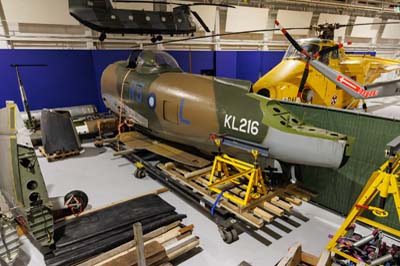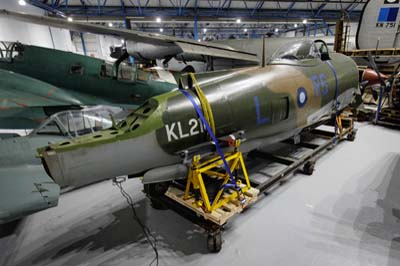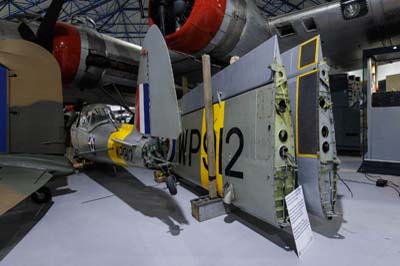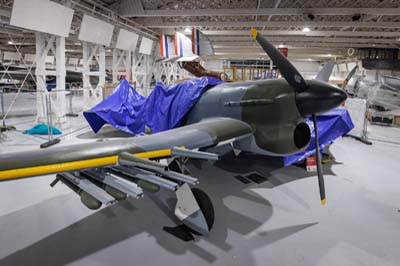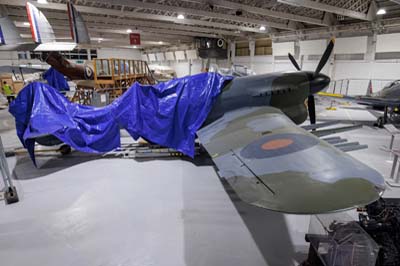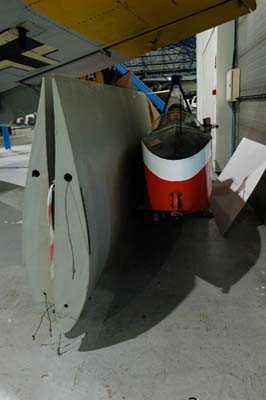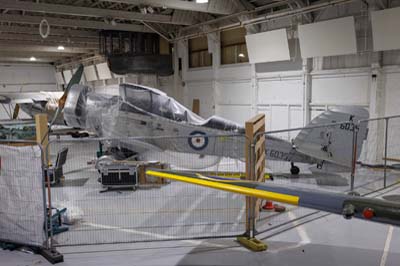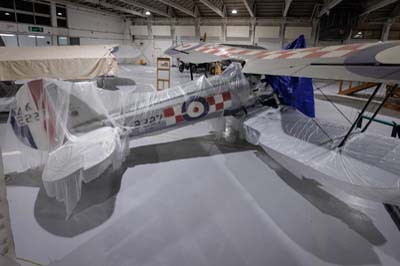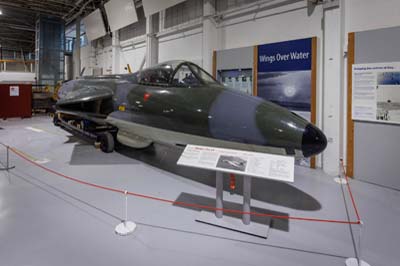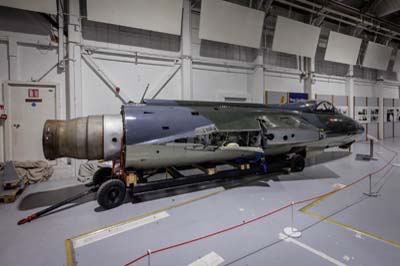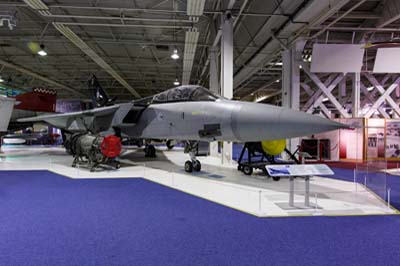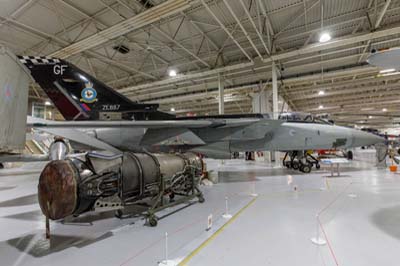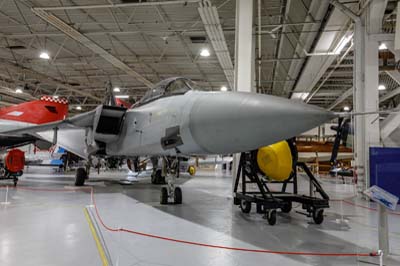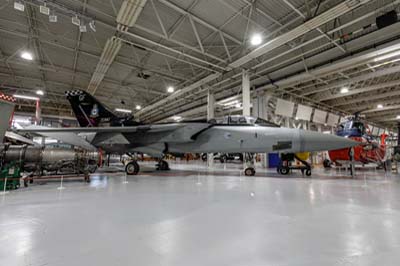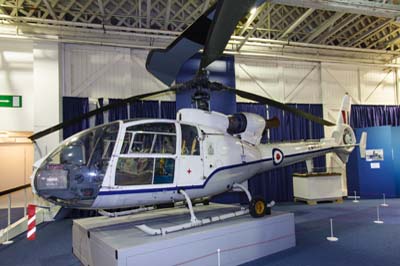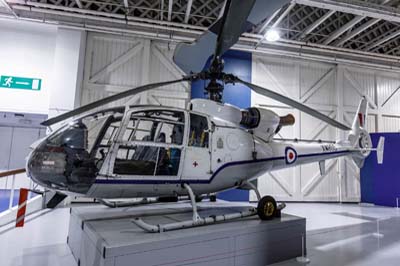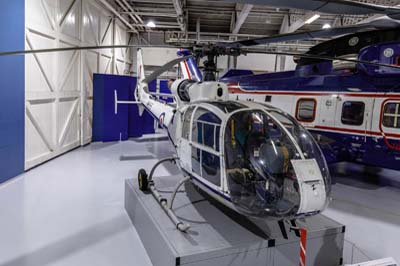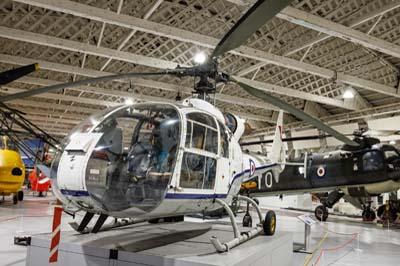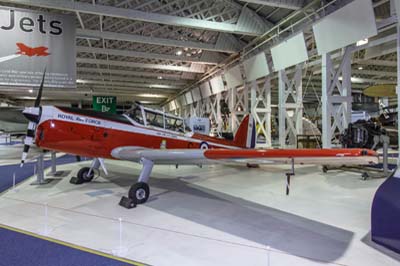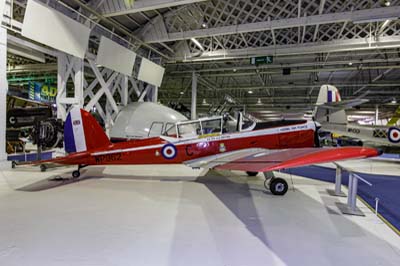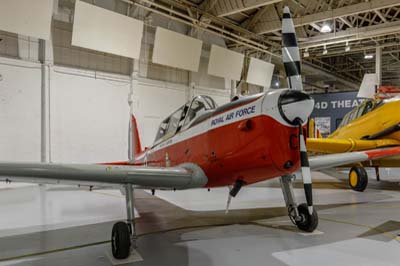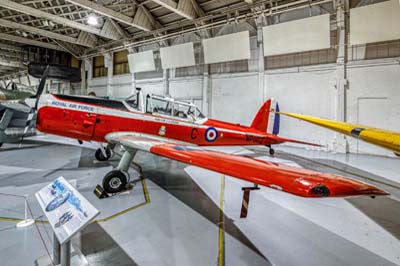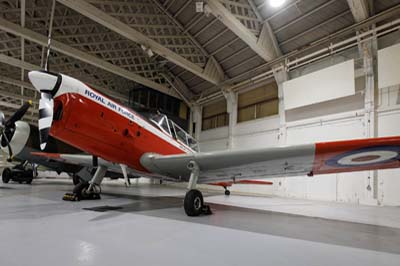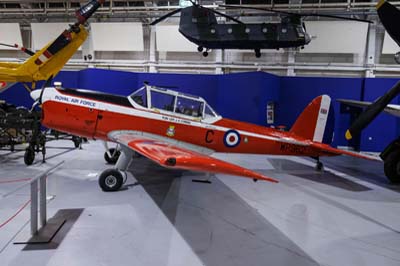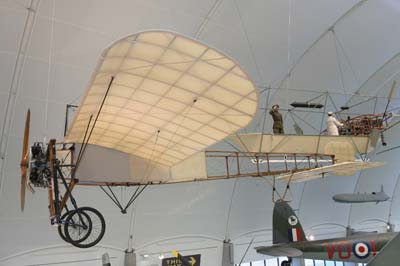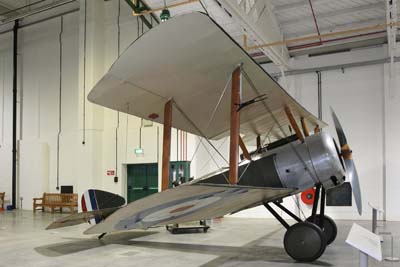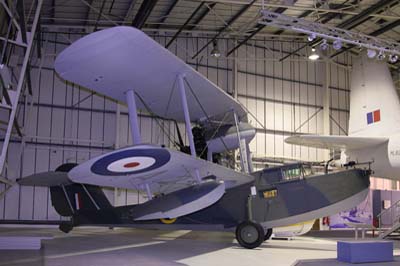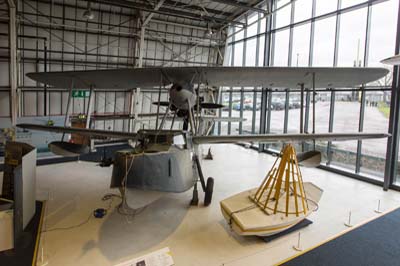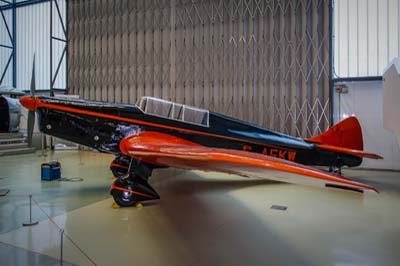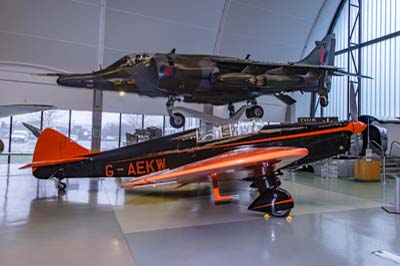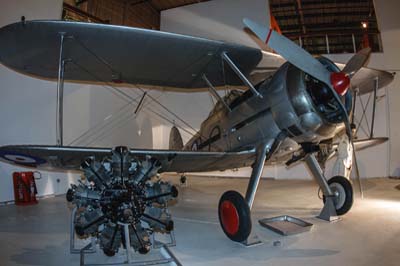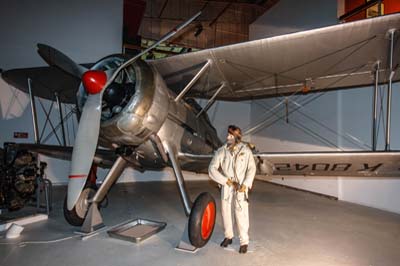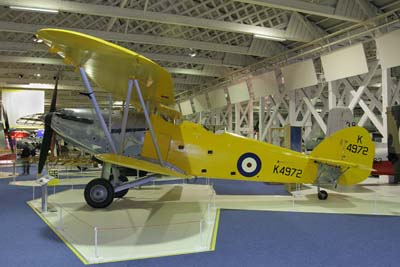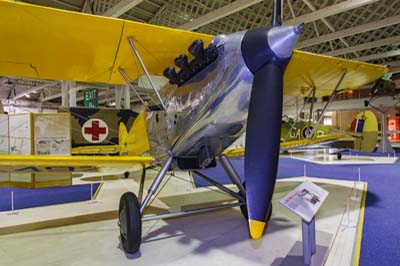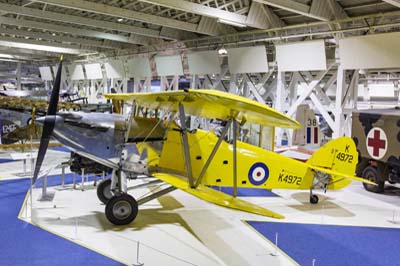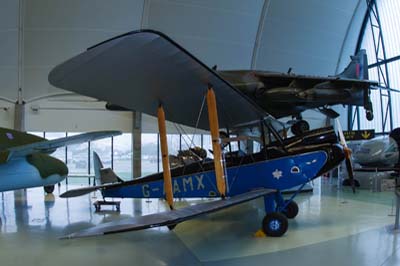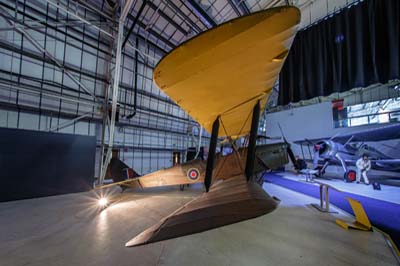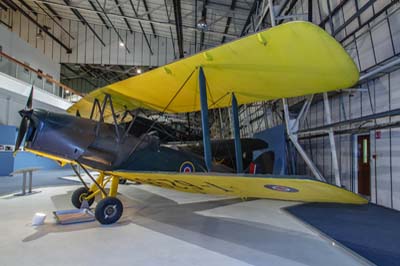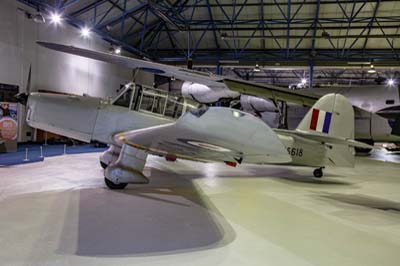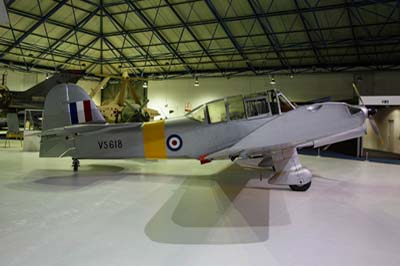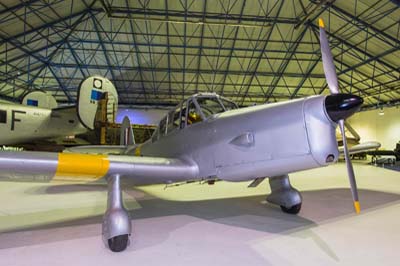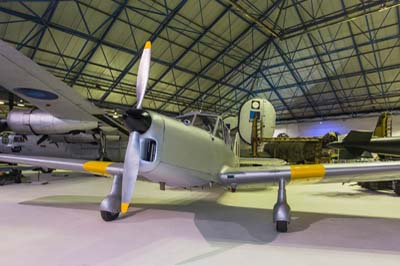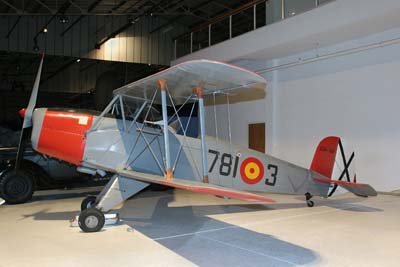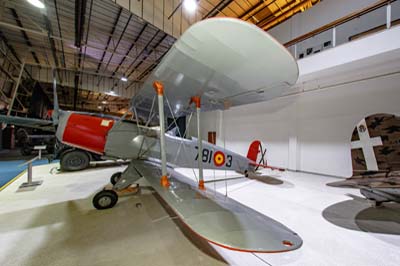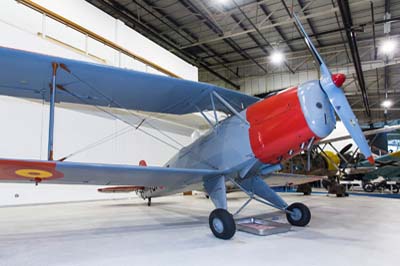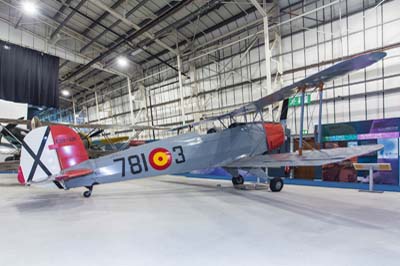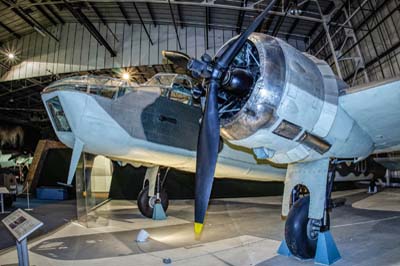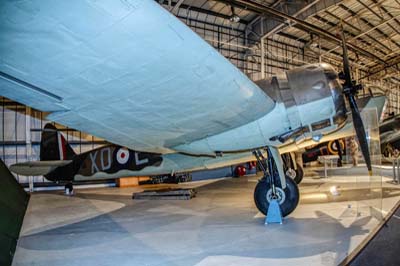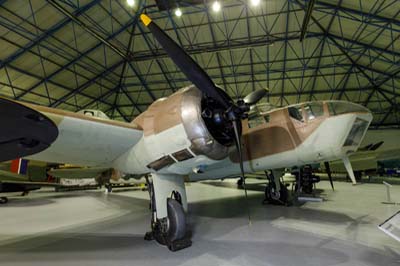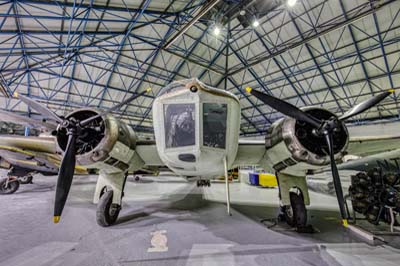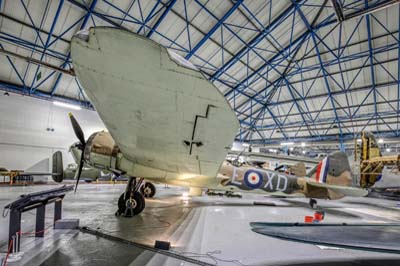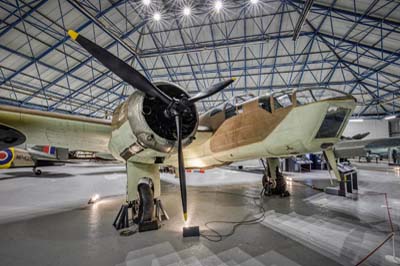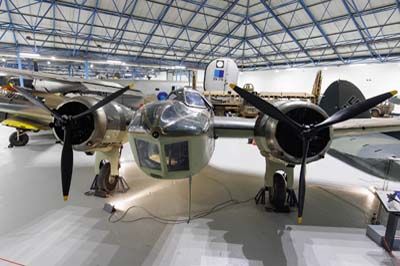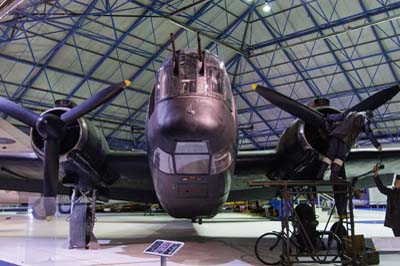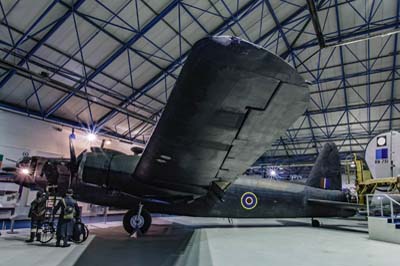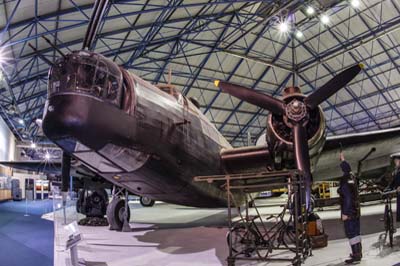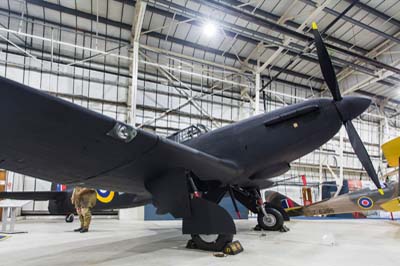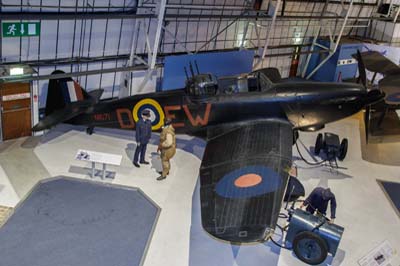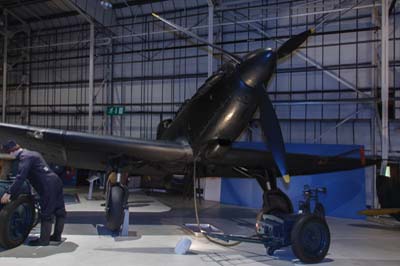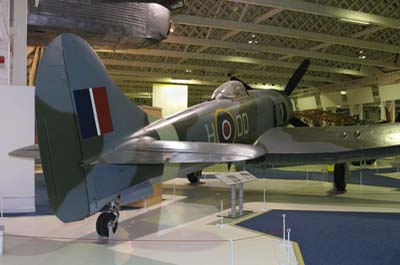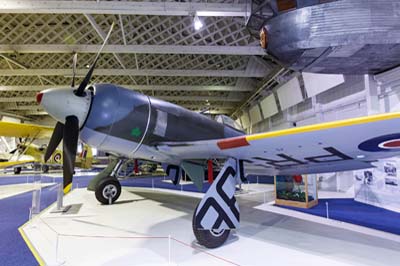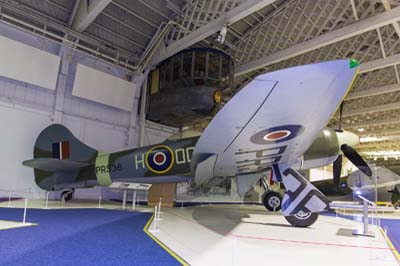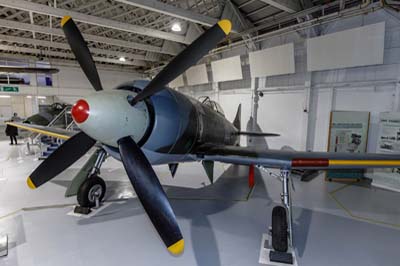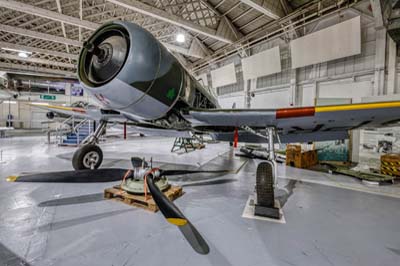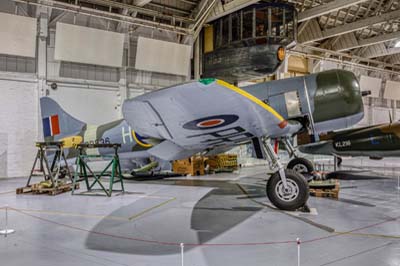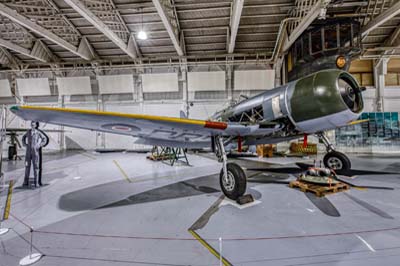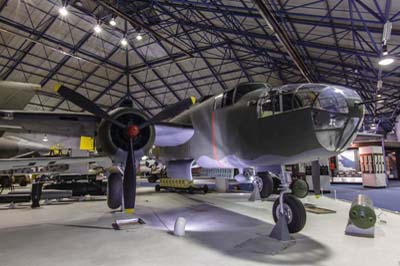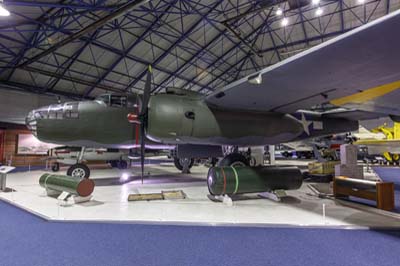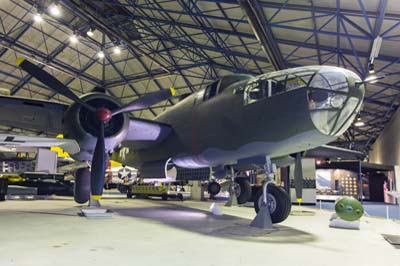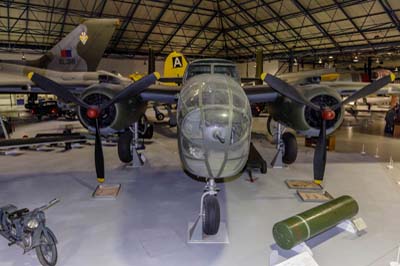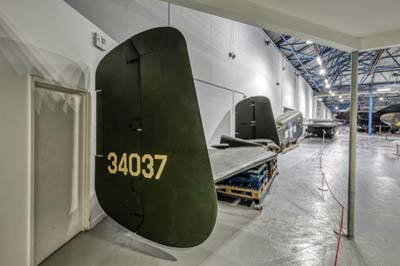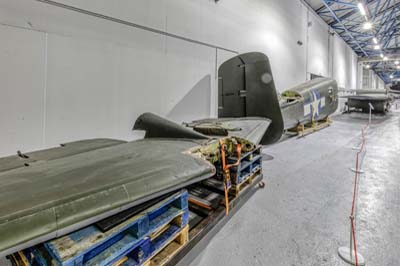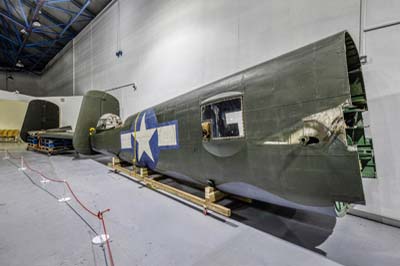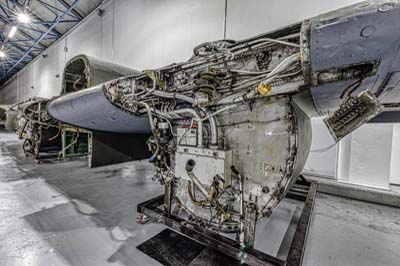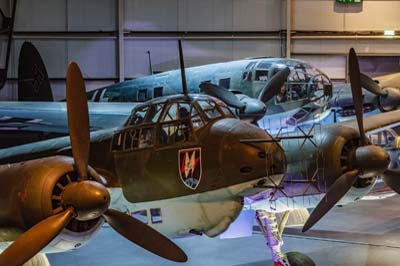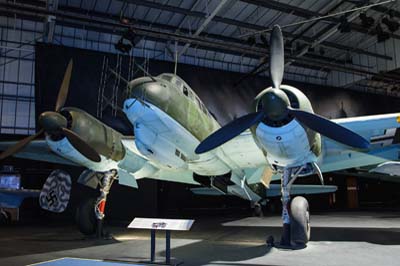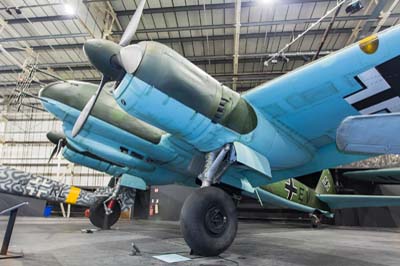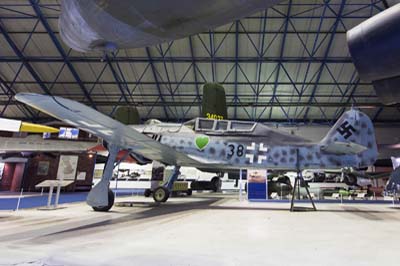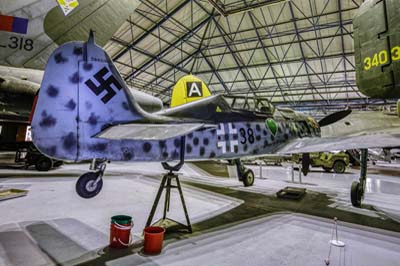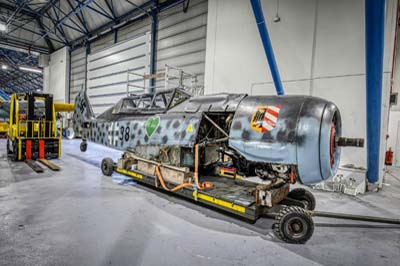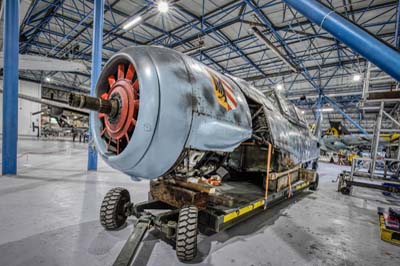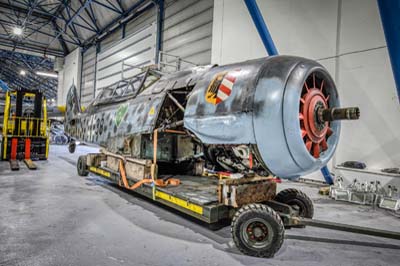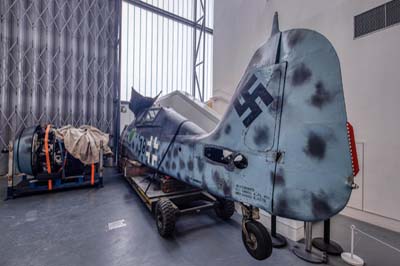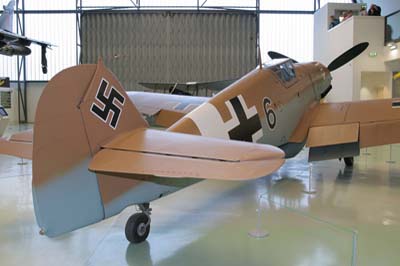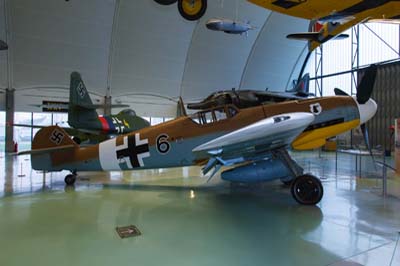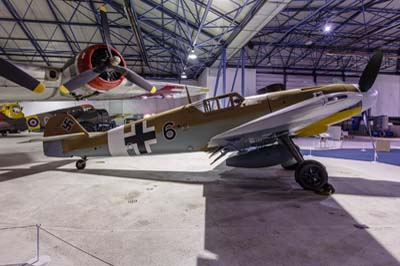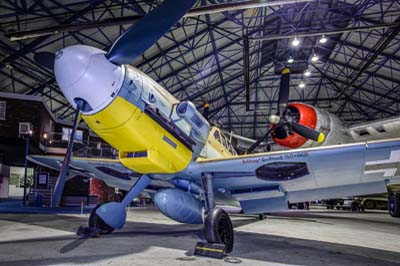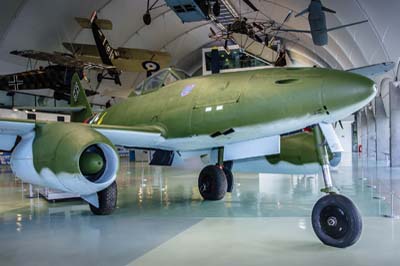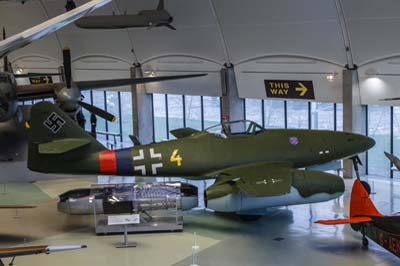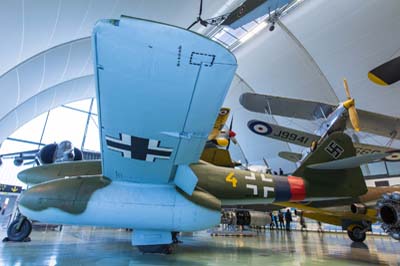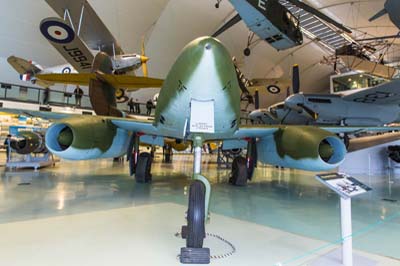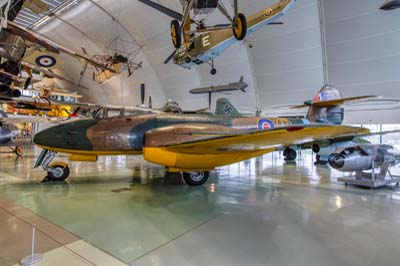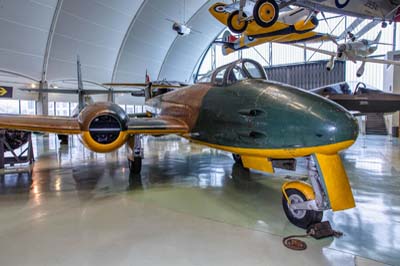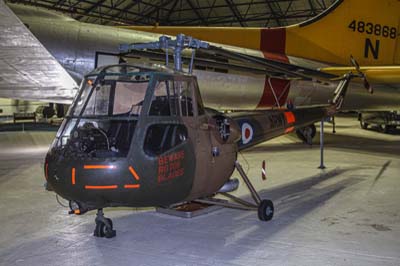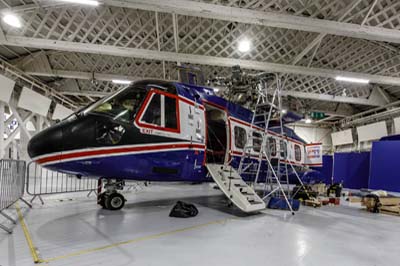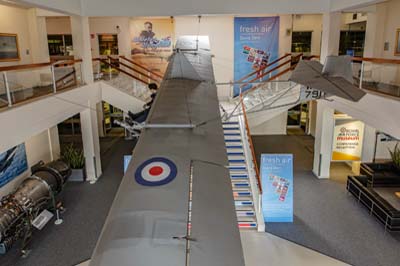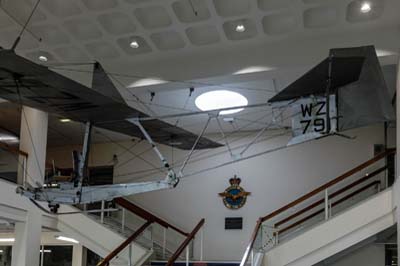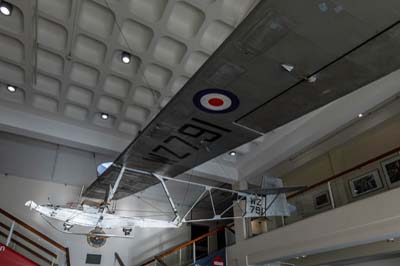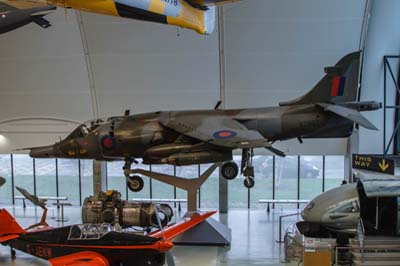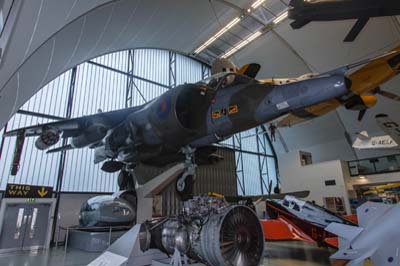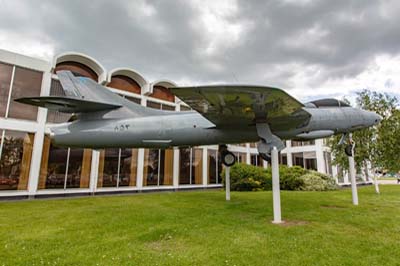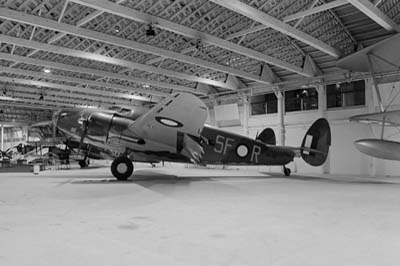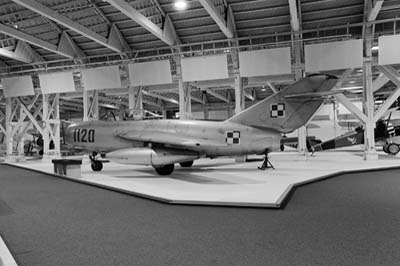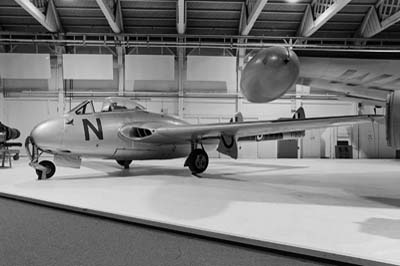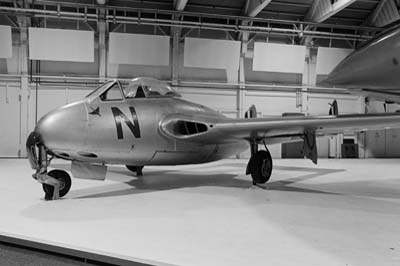Royal Air Force Museum
Hendon
1989, 2006, 2007, 2008, 2009, 2012, 2013, 2019, 2020, 2021, 2022, 2023, 2024 and 2025
|

|
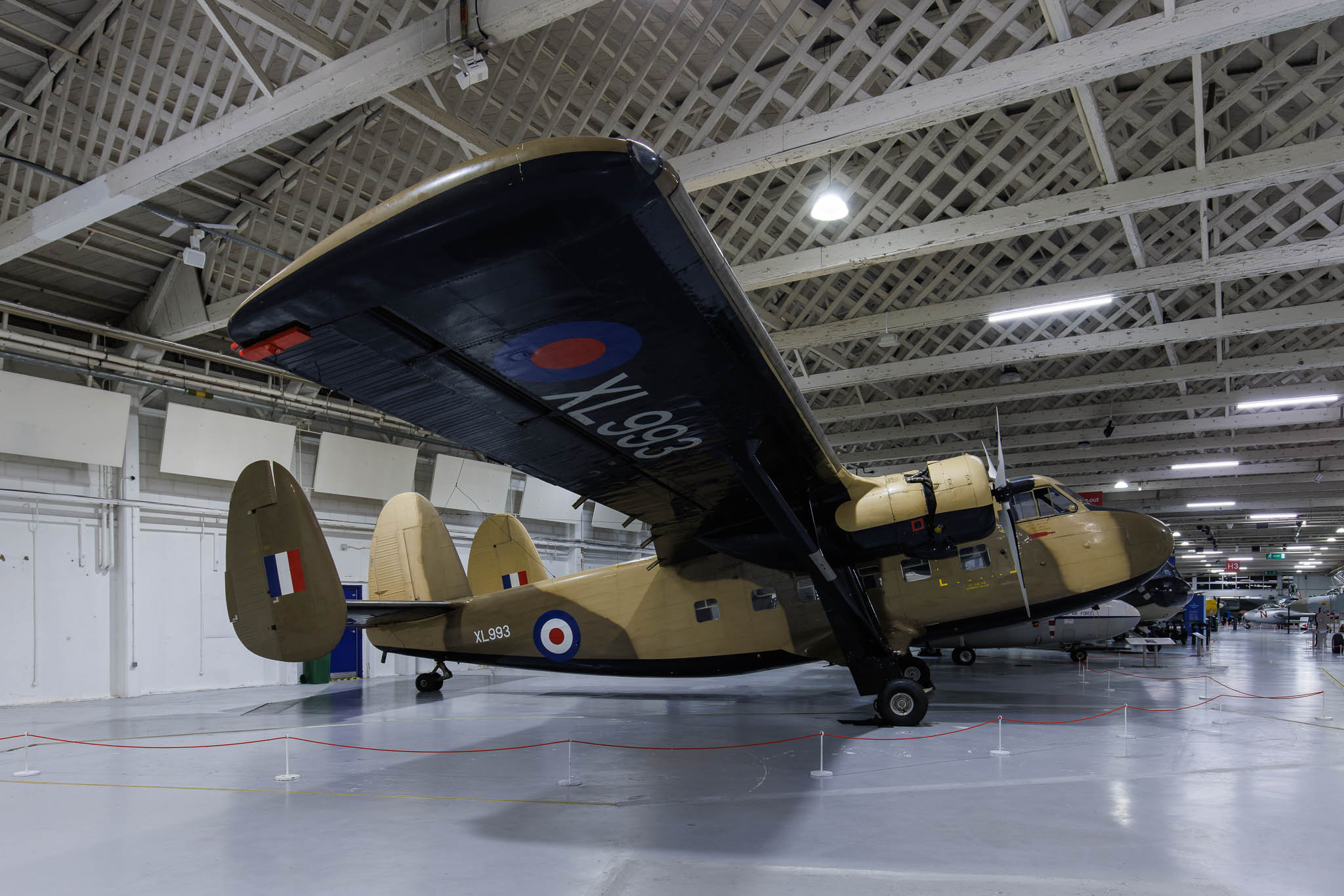 |
Left to right:
Scottish Aviation Twin Pioneer CC.2 (XL993). The Twin Pioneer was a follow-up to the same company's single-engine short take-off and landing (STOL) transport, the Pioneer. Initially designed as a 16-passenger civil transport aircraft the Twin Pioneer first flew in 1955. The RAF ordered 39 examples which entered service in October 1958 the last aircraft on frontline duties was retired in 1968. In 1965 an additional aircraft was acquired for use by the Empire Test Pilots School.
In 1964, Twin Pioneer XL993 took part in operations in the Radfan area, supporting actions against Yemeni-backed dissident Qutebi tribesmen north of Aden. For these missions, XL993 received a unique modification: the aircraft was fitted with two Nord SS.11 wire-guided missiles, mounted on outboard underwing pylons—a rare armament configuration for the type. Operating from RAF Khormaksar, XL993 carried out two live missile-firing sorties, conducted on 1 July and 28 July 1964 in the Khormaksar area. These missions formed part of the broader British counter-insurgency campaign during the Radfan conflict, and XL993's missile trials represented one of the few occasions where a Twin Pioneer was armed for offensive operations. XL993 had made its final flight to RAF Henlow, for storage on April 6, 1969. By May 2025 it had arrived from RAFM Cosford to here for display. |
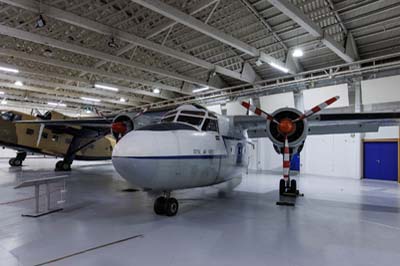 |
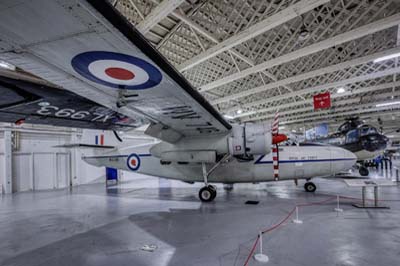 |
Left to right:
Hunting Percival Pembroke C.1 (WV746). Entering service in 1953, the Pembroke took over from the venerable Anson in the light transport and communications role. By May 2025 it had arrived at the RAF Museum Hendon. |
Gloster Meteor F.8 (WH301 later 7930M). The Gloster Meteor was the RAF's first operational jet fighter and saw combat during World War Two. By 1947 30 squadrons were equipped with 1,000 of the improved Mk.8 Meteors. The F.8 however did not actually see combat and some were eventually converted into target tugs.
The Meteor F8 on display started its service career at the Day Fighters Leaders School at the Central Fighter Establishment from 1952 to 1955. It then moved to 609 Squadron before passing to the RAF Flying College at Manby in 1956. It later served with 85 Squadron in 1965 after periods in storage. WH301 was given to the RAF Museum in 1967 and was stored at Henlow until it was put on display at Hendon in 1980. |
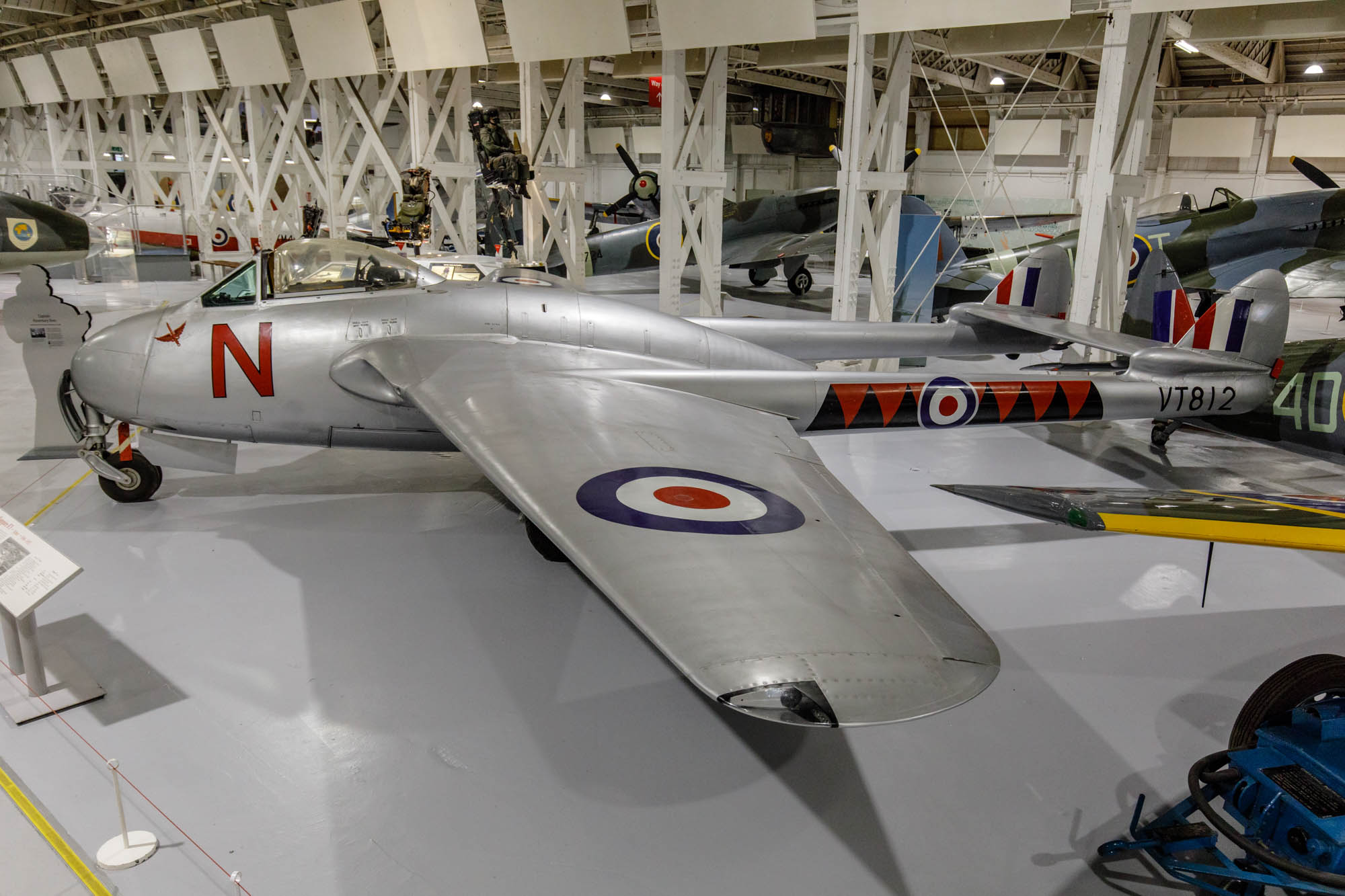 |
de Havilland DH.110 Vampire F.3 (VT812 'N' later 7200M). Work began in May 1942 on the prototype de Havilland DH.110, with the first flight taking place on September 20, 1943. The Vampire F.1 entered service with the RAF in mid 1946 followed by the longer range F.3 version.
VT812 was delivered in 1947 and allocated to 32 Squadron in 1948 then based at Nicosia, Cyprus, replacing their Spitfire FR.18’s. By 1950 it was with 614 Squadron at Llandow and later with 601 Squadron at North Weald before moving on to 602 Squadron at Abbortsinch. The surviving F.3’s were retired during 1953, being replaced by the improved FB.5 variant. Following a period of storage with 48 MU at Hawarden VT812 was allocated 7200M for ground instructional use in 1955. It was then put on display at various locations before moving to Abingdon by 1968 and later Colerne where it was refurbished. When Colerne closed in 1975 it was moved Cosford via Shawbury in 1976 for the Aerospace Museum. In 1978 it was transferred to the RAF Museum. In 1997 a full restoration was started at Cardington and completed at Cosford by 2003, prior to its return to Hendon for display. As photographed in 1989. |
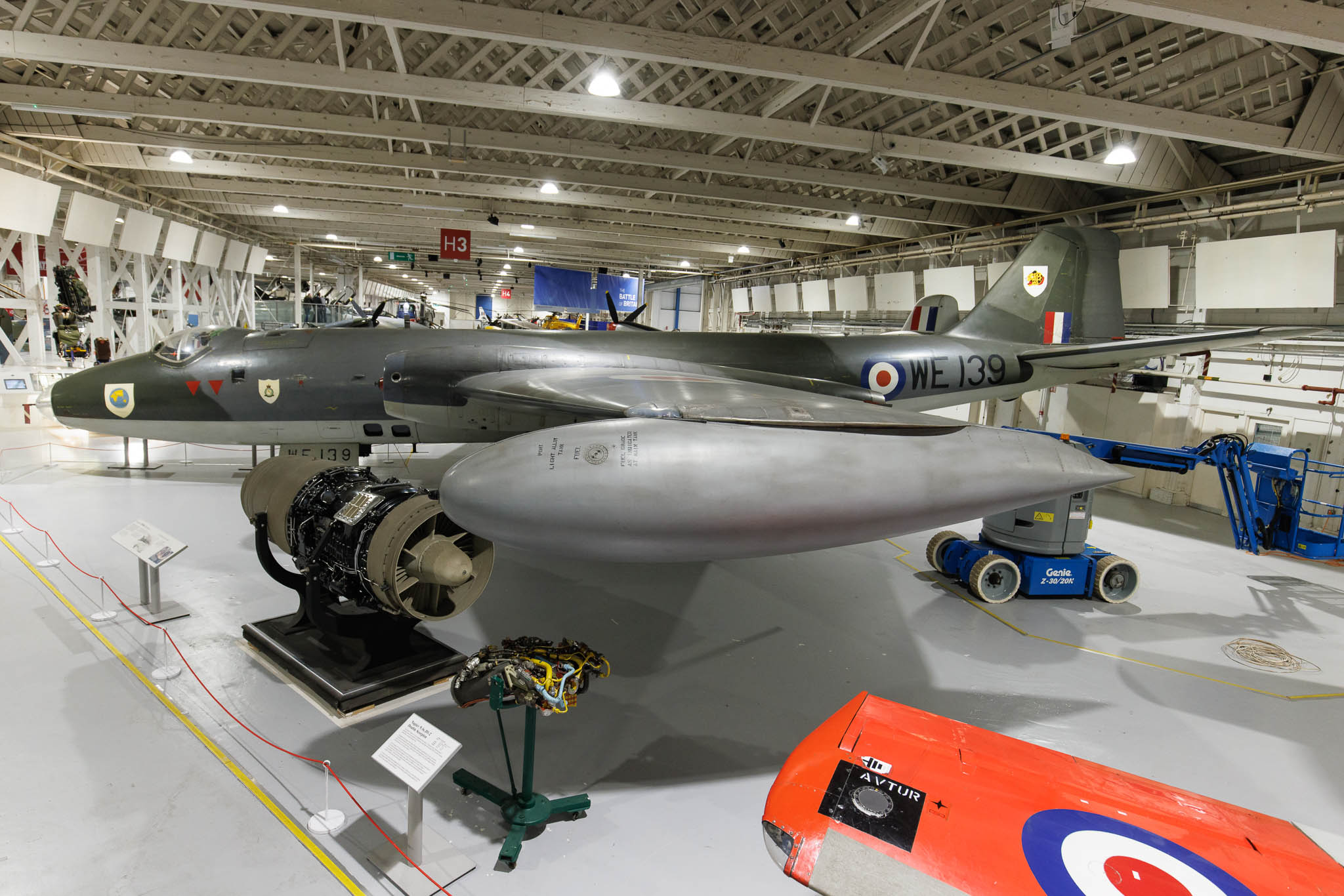 |
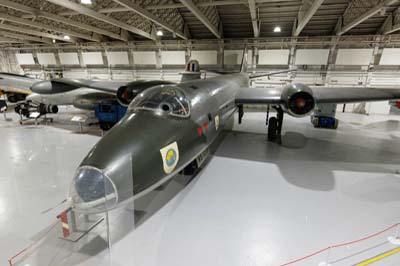 |
 |
English Electric Canberra PR.3 (WE139 later 8369M). The Canberra was the Worlds first jet-powered bomber when it entered service in 1949, replacing the obsolete Avro Lincoln. Later photo-reconnaissance versions replaced de Havilland Mosquito's, another World War Two designed aircraft. Eventually 1,352 Canberra's were built, 782 serving the RAF for over 50 years, during which time it achieved 20 World records before the last remaining PR.9s were retired in 2006.
WE139 was ordered in 1949 and first flew in 1953 it was delivered to RAF Manby and later moved to RAF Wyton where it was prepared for the New Zealand Air Race in which it took part later in 1953. It won the Speed Section of the 12,270 mile London to Christchurch route in a time of 29 hours, 51 minutes. In 1954 it was transferred to 69 Squadron at RAF Gütersloh and later RAF Laarbruch both in West Germany. By 1958 it was with 39 Squadron at Luqa, Malta. To make way for the newer Canberra PR.9’s it was transferred to 231 OCU at RAF Bassingbourne in 1962, remaining there till its final flight in 1969 before it was put into storage at RAF Henlow. It was moved to the RAF Museum at Hendon in 1971. |
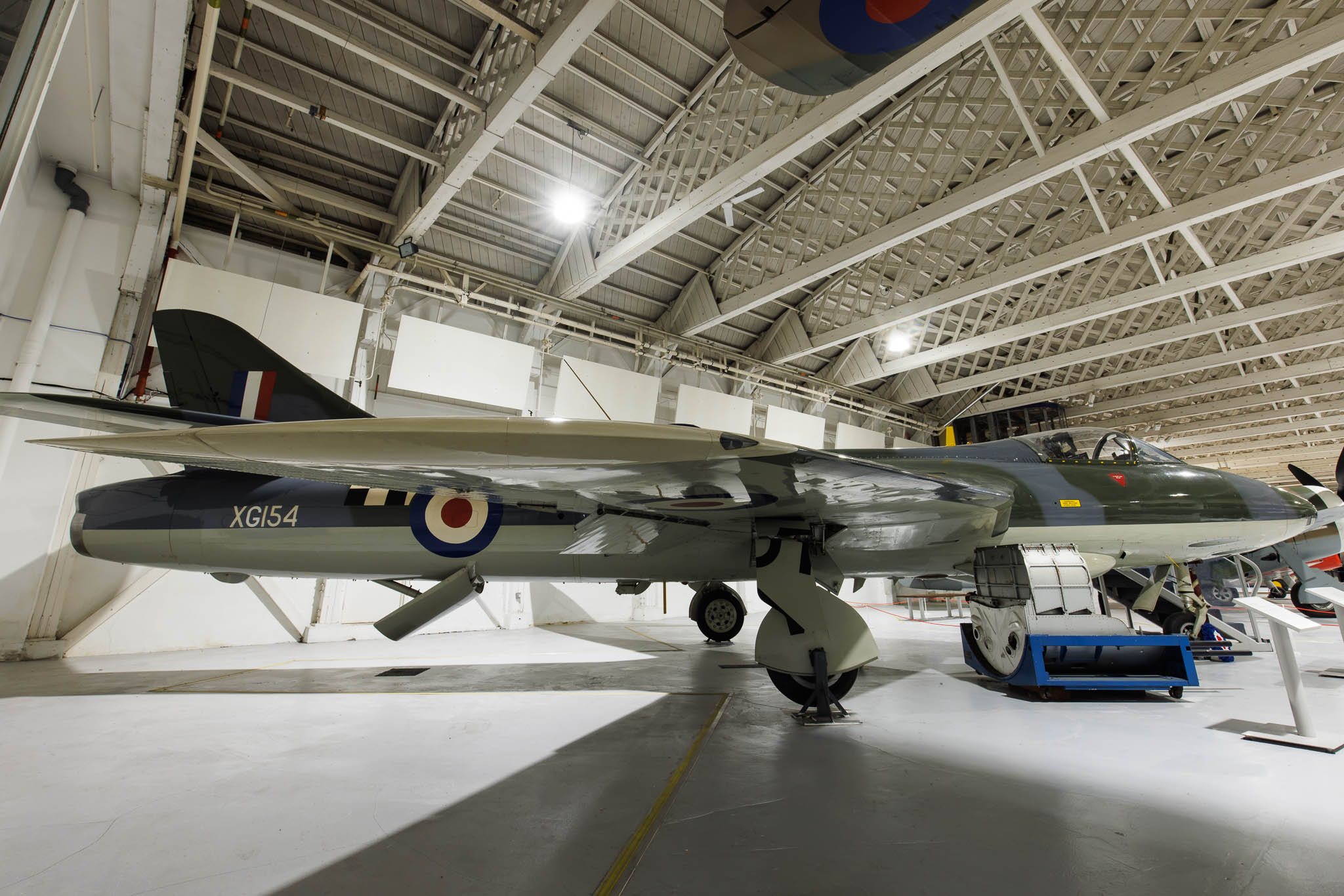 |
Left to right:
Hawker Hunter FGA.9 (XG154 and 8863M). Based on the Hawker Sea Hawk, the first production Hunter F.1 flew in 1951, following flight testing of the P.1052 and P.1081 test aircraft. Neville Duke broke the world speed record in a Hunter F.3 in 1953 when flying at 727.63 mph. Eventually 1,972 Hunters were built serving with 19 air forces to 1994. In 2007 two of a large number of privately operated Hunters were contracted to fly once again for the RAF. The last FGA.9 flew with 8 Squadron till its disbandment in 1971.
XG154 was built at Bitteswell as an F.6 and was delivered in 1956 to join 56 Squadron later in the year. By 1957 it was with 66 Squadron at RAF Acklington. In 1959 it was one of 36 to be modified to FGA.9 standard. In 1960 it flew with 43 Squadron before its transfer to 8 Squadron based at RAF Khormaksar in Aden in 1963. Following a number of deployments around the Middle East and Africa up to 1971, XG154 was transferred to 229 OCU which became the longest serving RAF unit to operate the Hunter. By 1976 it was with the Fleet Air Arm at RNAS Brawdy later transferring to 1 TWU at RAF Brawdy. Following its final flight in 1984 it was put into storage at St Athan. It had flown for 5,500 hours and had made 675 landings. In 1989 it was moved to RAFM Hendon. |
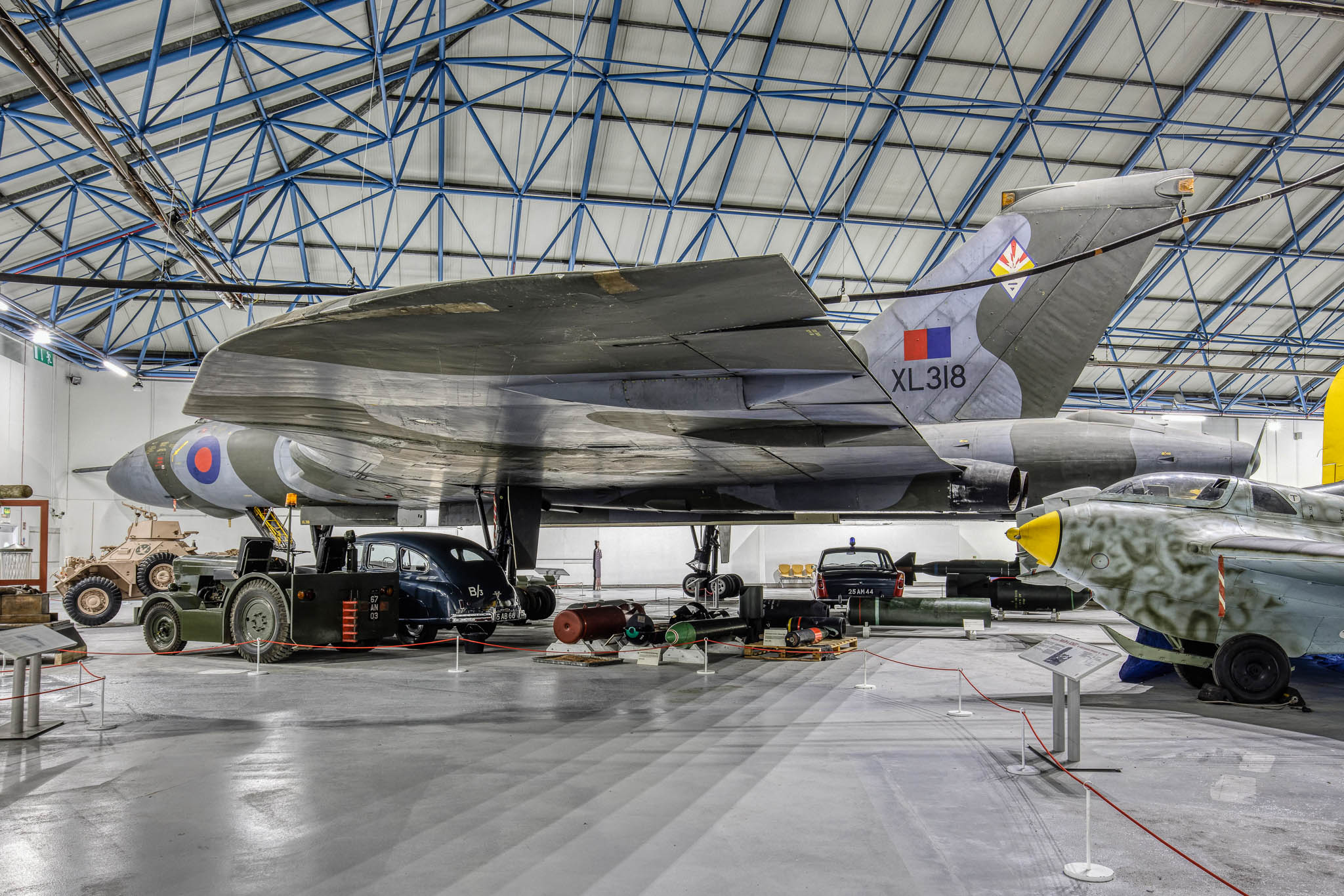 |
Avro Vulcan B.2 (XL318). The Vulcan B.1 took to the air in 1952 followed by the B.2 variant in 1956, which was modified to carry the Blue Steel stand-off nuclear missile. The Vulcan's mission changed from high level to low-level in 1966 with the withdrawal of their nuclear weapons in 1970. As a conventional bomber and with in flight refuelling it continued in service until 1984.
XL318 was delivered to 617 Squadron in 1961, it later joined Scampton Wing (27, 83, 617 Squadrons) in 1965. Back with 617 Squadron in 1969 it then moved to 230 OCU in 1972. In 1975 it was with Waddington Wing (9, 44, 50, 101 Squadrons) before moving back to 230 OCU and finally returning to 617 Squadron once again in 1981. In 1982 following retirement it was moved to RAFM Hendon. |
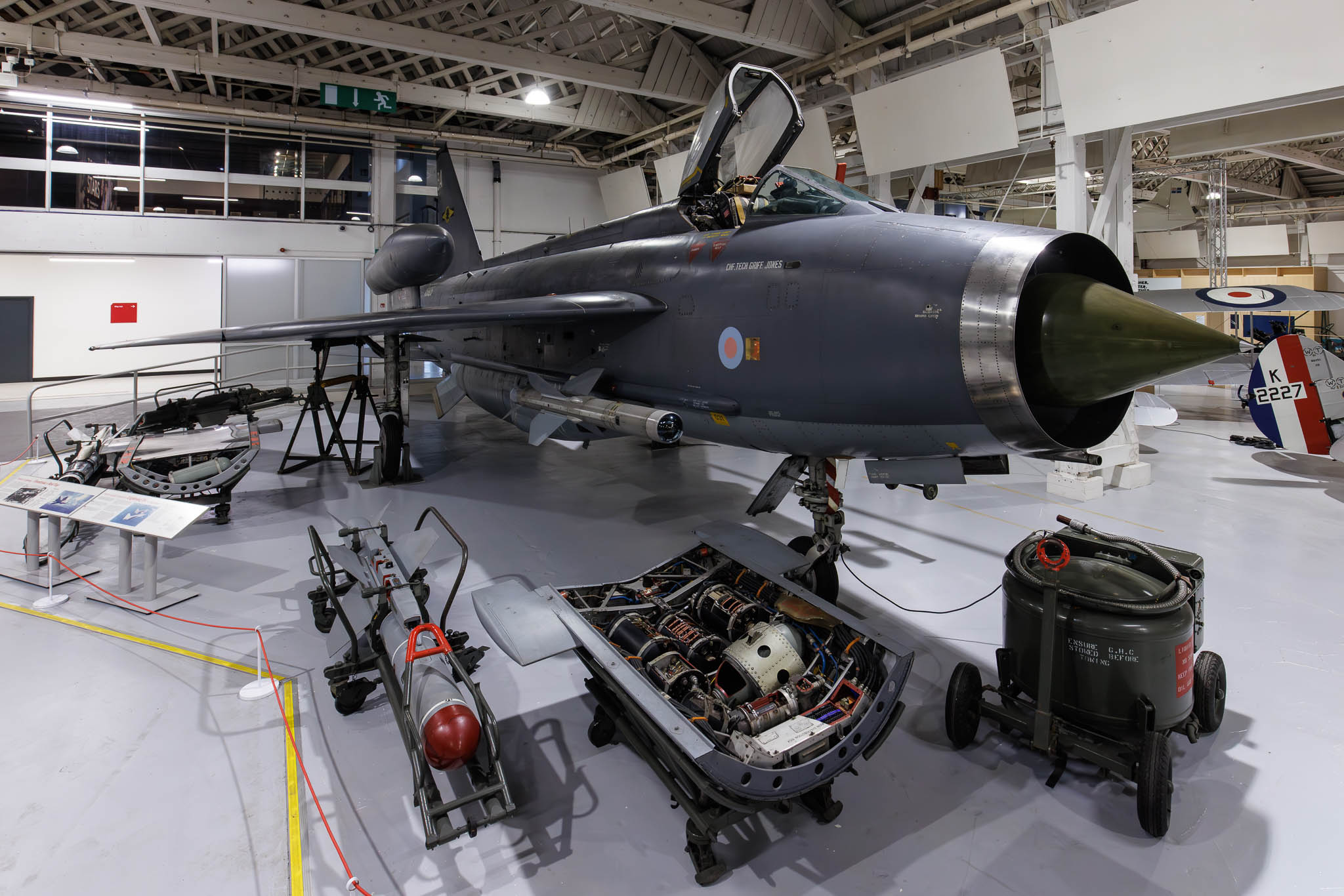 |
British Aircraft Corporation Lightning F.6 (XS925 'BA'). The English Electric Lightning, when it became operational in 1960, was the first truly supersonic fighter and had twice the top speed of other fighters in the RAF. It was employed on air defence duties for an extraordinary 28 years till its retirement on April 30, 1988 at RAF Binbrook. The F.1 variant (18 F.1 and 28 F.1A built) initially served with 74 Squadron and later by the F.2 (44 built) with 19 Squadron in 1962 and was followed in to service by the F.3 (70 plus 16 F.3A built) in 1962. The F.6 (39 built) had a longer range and entered service in 1965. Additionally 20 T.4 and 22 T.5 two seat side-by-side trainers were delivered.
XS925 was delivered in 1967 and served with 74, 11, 23 and 5 Squadrons before it was put into storage at Binbrook in 1986. It joined the RAF Museum for display in 1988. Two early P.1 Lightning prototypes are on display at RAF Museum - Cosford. |
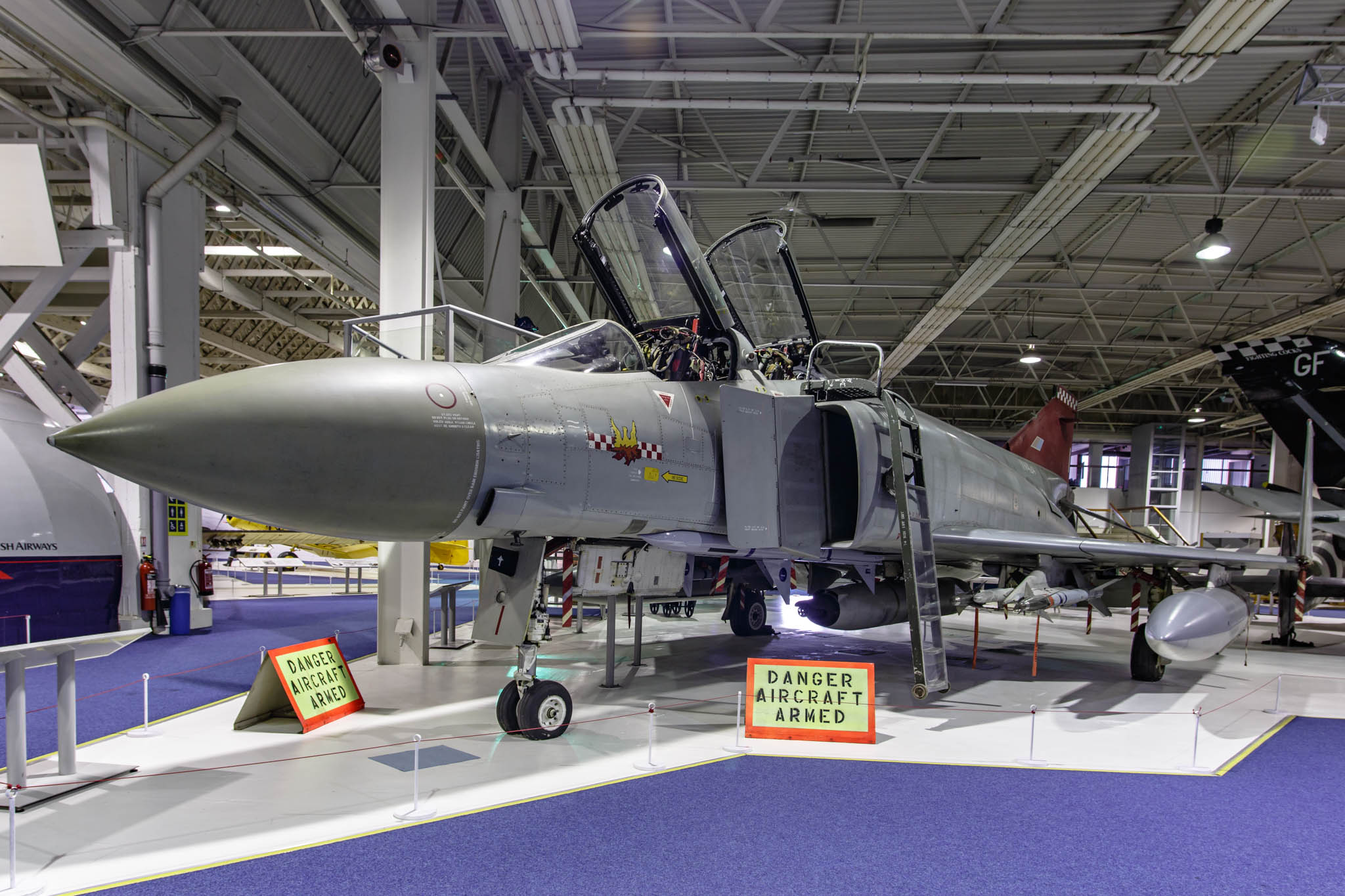 |
McDonnell Douglas F-4M Phantom FGR.2 (XV424 later 9152M) Originally developed for the US Navy, the Phantom is a two-seat, twin-engine, all-weather, long-range interceptor jet fighter/fighter-bomber and entered service in 1960. The Royal Navy ordered 52 Phantom FG.1s to fulfil the fighter/ground attack role and the RAF ordered 118 Phantom FGR.2s for the fighter/ground attack/reconnaissance role. The Phantom FG.1s and FGR.2s entered service in 1969 and were supplemented by 15 former US Navy F-4Js in the 1980s. Following the introduction of the Tornado F.3 the last RAF Phantom was retired in 1992 when 74 Squadron disbanded.
XV424 was delivered to the RAF in 1969 and entered service with 6 Squadron at RAF Coningsby with eleven other FGR.2s. In 1972 it served briefly with 54 Squadron and 228 OCU before returning to 6 Squadron. In 1974 it was transferred to 29 Squadron when 6 Squadron disbanded and moved on to 111 Squadron at RAF Leuchars in 1976 and then on to 56 Squadron at RAF Wattisham in 1978. In 1979 it was back at RAF Coningsby with 228 OCU as the RAF's solo display Phantom. In 1985 it served with 92 Squadron at RAF Wildenrath, before returning to 29 Squadron in 1986 and 228 OCU once again in 1987. In 1988 it was moved to RAF Wattisham where it served with 56 Squadron It made it last operational flight in July 1992, before moving by road to Hendon in the November. |
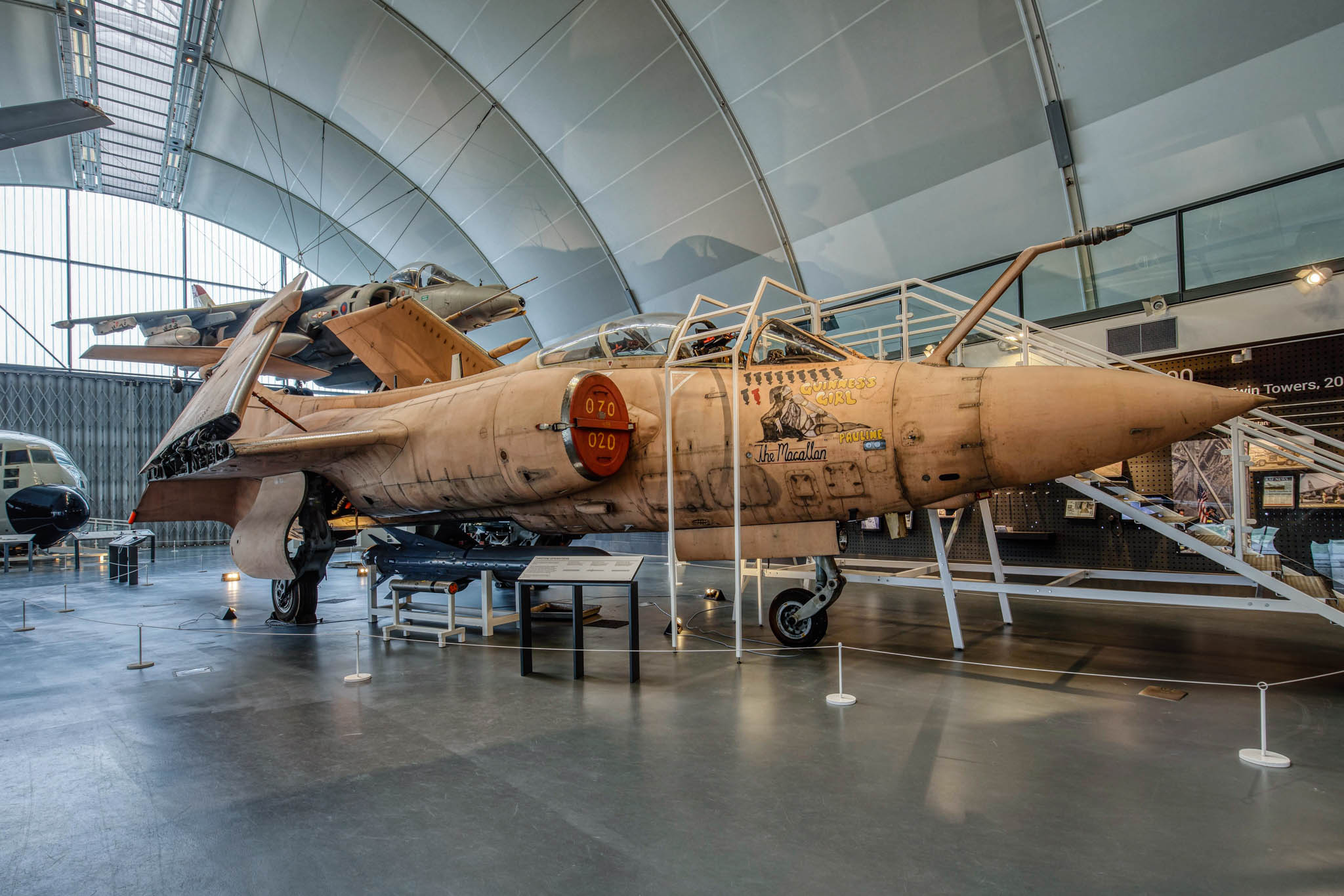 |
Hawker Siddeley Buccaneer S.2B (XW547 'R' later 9095M/9169M). The Blackburn Buccaneer was designed for the low-level strike role and was in service with the Royal Navy from 1962 to the 1970s when they were transferred to the RAF who operated the Bucc' between 1969 to 1994.
The aircraft on display was first delivered to 15 Squadron in 1972 when based at Laarbruch in Germany. By 1974 it had been transferred to 12 Squadron and later 237 OCU and 216 Squadron at Honington. In 1981 it moved north to Scotland with 12 Squadron at Lossiemouth. After a spell with 208 Squadron and 237 OCU it returned to 12 Squadron where it saw out its service days before being retired in 1991. By 1993 it was on display at the RAFM at Cosford. It has retained its Gulf War sand 'pink' camouflage applied for Operation Granby along with nose art 'Guinness Girl' and 'Sky Pirates'. |
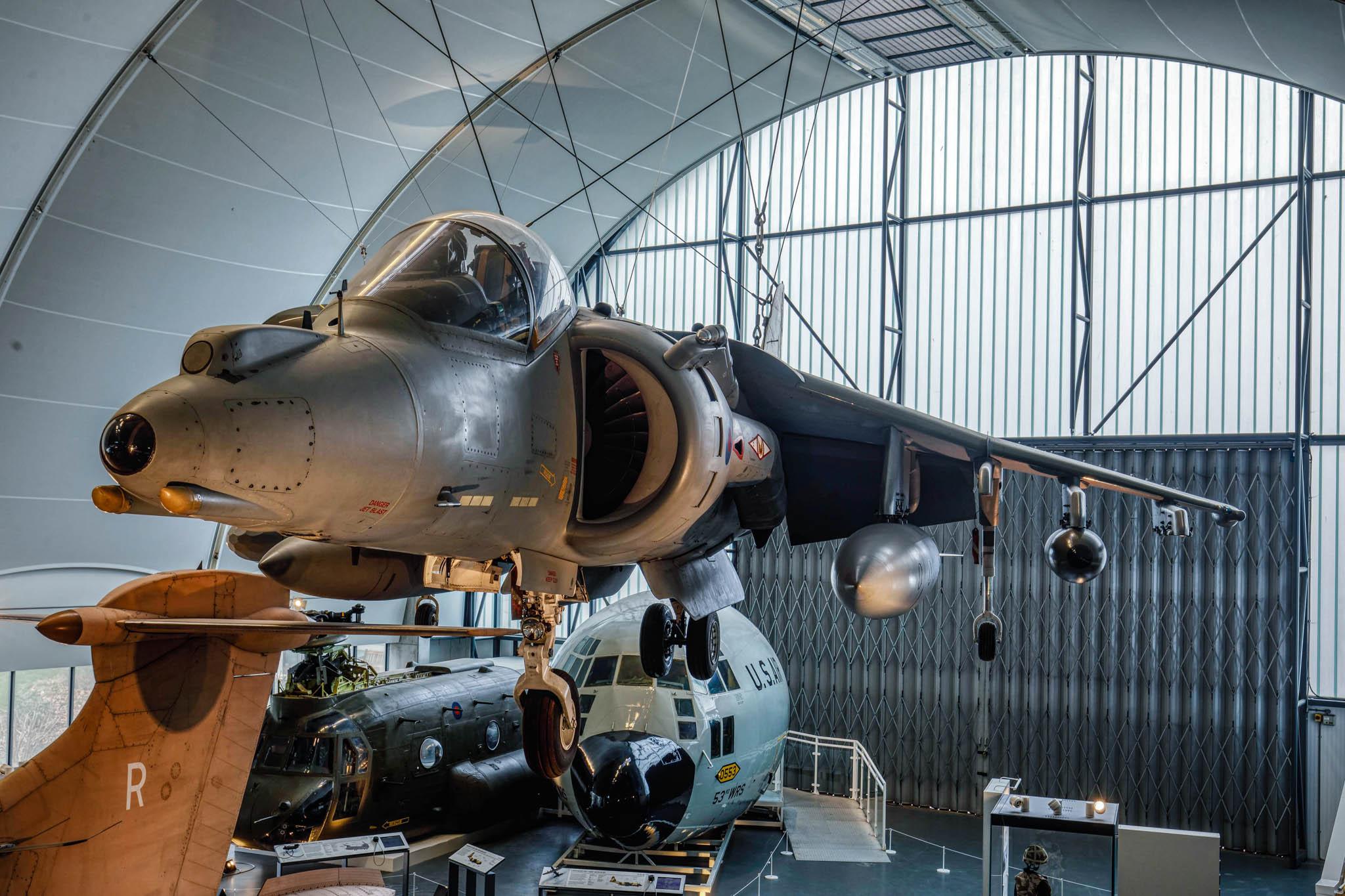 |
Left to right:
BAE Harrier GR.9A (ZG477). It has a 1(F) Squadron special tail applied at the end of its service. The Harrier was the first operational jet fighter capable of vertical take-off and landing. It was utilised by the RAF in the ground attack and reconnaissance role and for Close Air Support (CAS). The GR.3 was developed from the GR.1 and had a more powerful engine with improved attack sensors and electronic counter-measures. |
Panavia Tornado GR.1B (ZA457 'AJ-J'). Panavia was a consortium put together by the United Kingdom, West Germany and Italy to develop a combat aircraft in three main versions; Tornado IDS (Interdictor/Strike), Tornado ECR (Electronic Combat/Reconnaissance and Tornado ADV (Air Defence Variant). 992 Tornados were built including 72 for Saudi Arabia. The first British prototype flew in 1974 and was initially the designated the GR.1 when it entered service in 1980, 142 Tornados were later upgraded to GR.4/4A standard as a mid-life update, entering service in 1998. It still is the RAF's primary long-range strike attack aircraft and is fitted on each side of the nose two 25mm cannons. Capable of flying in all weather and at low-level, using its terrain-following, ground-mapping radar. It has Forward Looking infrared (FLIR) and linescan imaging systems to help fulfil its reconnaissance role, along with a 'RAPTOR' (Reconnaissance Airborne Pod TORnado) reconnaissance pod. For close air support and interdiction, the aircraft would be equipped with iron bombs, cluster bombs and laser-guided bombs. In the defence suppression role, it is equipped with anti-radar missiles. The Tornado GR.4/4A can also carry 'TIALD' (Thermal Imaging and Laser Designator) pod, first introduced during the first Gulf War in 1990.
ZA457 was built by British Aerospace at Warton in 1983 and was delivered to the Tornado Operational Evaluation Unit at Boscombe Down in the same year. It later served with 9, 15, 17 and 617 Squadrons. In 1994 it was modified to a GR.1B standard to carrying the Sea Eagle anti-shipping missile. It last served with 2(AC) Squadron from 2001 till 2002 before being delivered by road to RAF Museum Hendon in July 2003 after a period of spare reclamation at DARA St Athan. The aircraft has 617 Squadron markings including two LGB (Laster Guided Bombs) mission symbols representing attacks made on Iraqi targets during Gulf War I. |
 |
| SEPECAT Jaguar GR.1A (XX824 'AD' later 9019M). Taking to the air in September 1968 for the first time this Anglo-French designed jet attack aircraft was originally used by the RAF and the French Air Force in the close air support role. The Jaguar served with the French Air Force as the main strike/attack aircraft until 2005, and with the RAF until April 2007. |
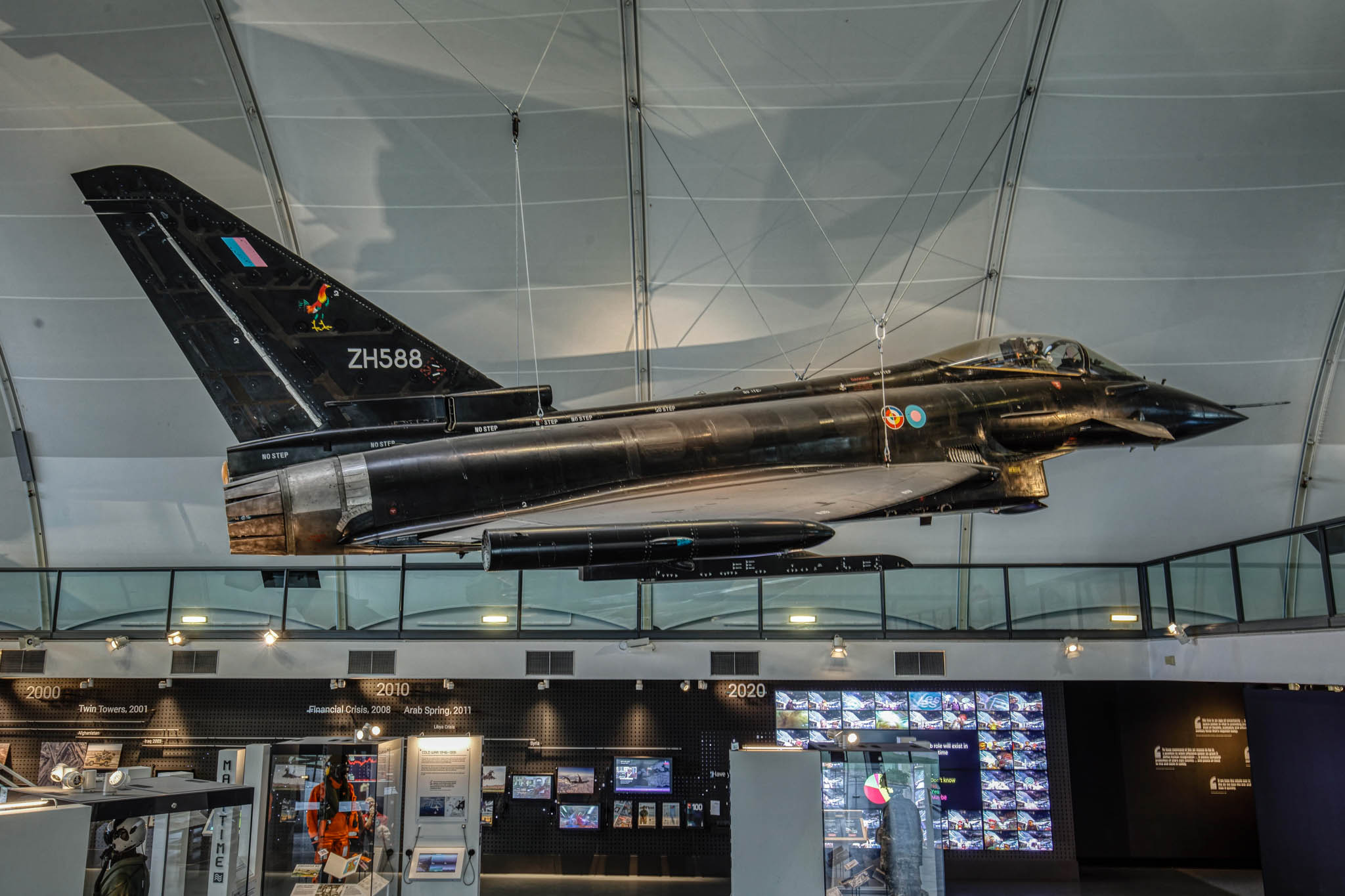 |
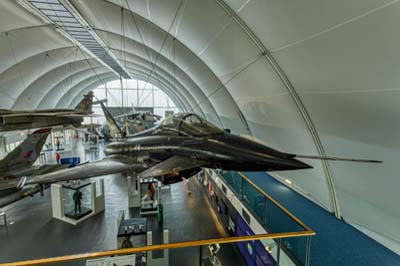 |
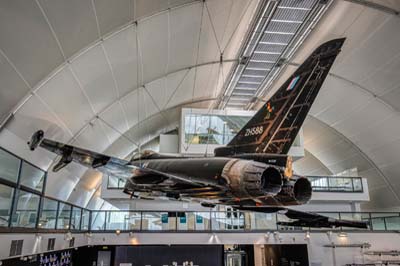 |
Eurofighter EF2000 Typhoon (ZH588). The UK, Germany, Italy and Spain from 1986 started work proper on this state-of-the-art multi-role aircraft. The consortium utilised development work from earlier projects including the European Combat Fighter (ECF) from 1979, the Agile Combat Aircraft (ACA) from 1982 and the Experimental Aircraft Program (EAP) from 1983 and also the European Fighter Aircraft (EFA) program also from 1983. The BAE EAP prototype aircraft was rolled out at Warton in 1985 and from 1986 flew for five years for flight testing. By 1992 work started on the EF2000, as it was now named, this final design was very similar to the EAP. The first flight of the EF2000 took place in March 1994. In 2002 it was finally agreed that production would be set at; 232 for the UK, 180 for Germany, 121 for Italy and 87 for Spain. Each consortium member manufactures all the parts of the whole production, but each nation’s own aircraft are assembled in their own countries. The German Air Force, Italian Air Force, Royal Air Force (Typhoon) and Spanish Air Force (Tifón) accepted their first Eurofighters in 2003.
ZH588 (DA2) was rolled out from BAE Warton in 1993 and first flew on April 6, 1994 starting the 575 sorties scheduled for its test life. Its first supersonic flight (Mach 1.05) took place in June 1995 and by August 1996 it had made 132 test flights In December 1997 it reached a speed of Mach 2. In 2000 it was painted black to hide nearly 500 pressure transducers used for further flight tests. By April 2002 DA2 had made 419 test flights. In 2007 it made its final flight into Coningsby and following some spares recovery there and C-17 portability trials at Brize Norton it was taken by road to the RAF Museum at Hendon in January 2008. |
Slingsby T.31B Cadet TX.3 (XA302). The Slingsby Cadet first flew in 1935 and was utilised by the Air Training Corps as the Cadet TX.1 from the 1950s.
XA302 was part of a batch of 32 Cadets built by Slingsby Sailplanes at Kirbymoorside from 1950. In 1952 it was allocated to 22 Gliding School (GS), RAF Kirton-in-Lindsey. It operated with a number of Gliding Schools and Gliding Centres until it was withdrawn by the Air Cadets in 1985. In 1987 it was donated to Sqn Ldr William Connell Walker OBE who had prepared 1,000 cadets for their first solo on XA302 between 1961 and 1967. By 1996, with an estimated 20,122 flights recorded, it was stored at RAF Syerston. In 2005 it was donated to RAFM Hendon where it was put on display in the historic hangars in March 2006. In November 2025 it had been dismantled in preparation for a move within the museum or elsewhere. |
| Hawker Siddeley Gnat T.1 (XR977) former Red Arrows display team aircraft. The Gnat is swept-wing subsonic fighter aircraft that was developed and produced by Folland Aircraft as an advanced jet trainer. XR977 made first flight on January 1, 1964, before being delivered to No.4 FTS at RAF Valley. 105 Gnats served with the RAF until November 1978. The Red Arrows flew the Gnat from 1966 until 1979. It was transported from Cosford to Hendon in 2018. |
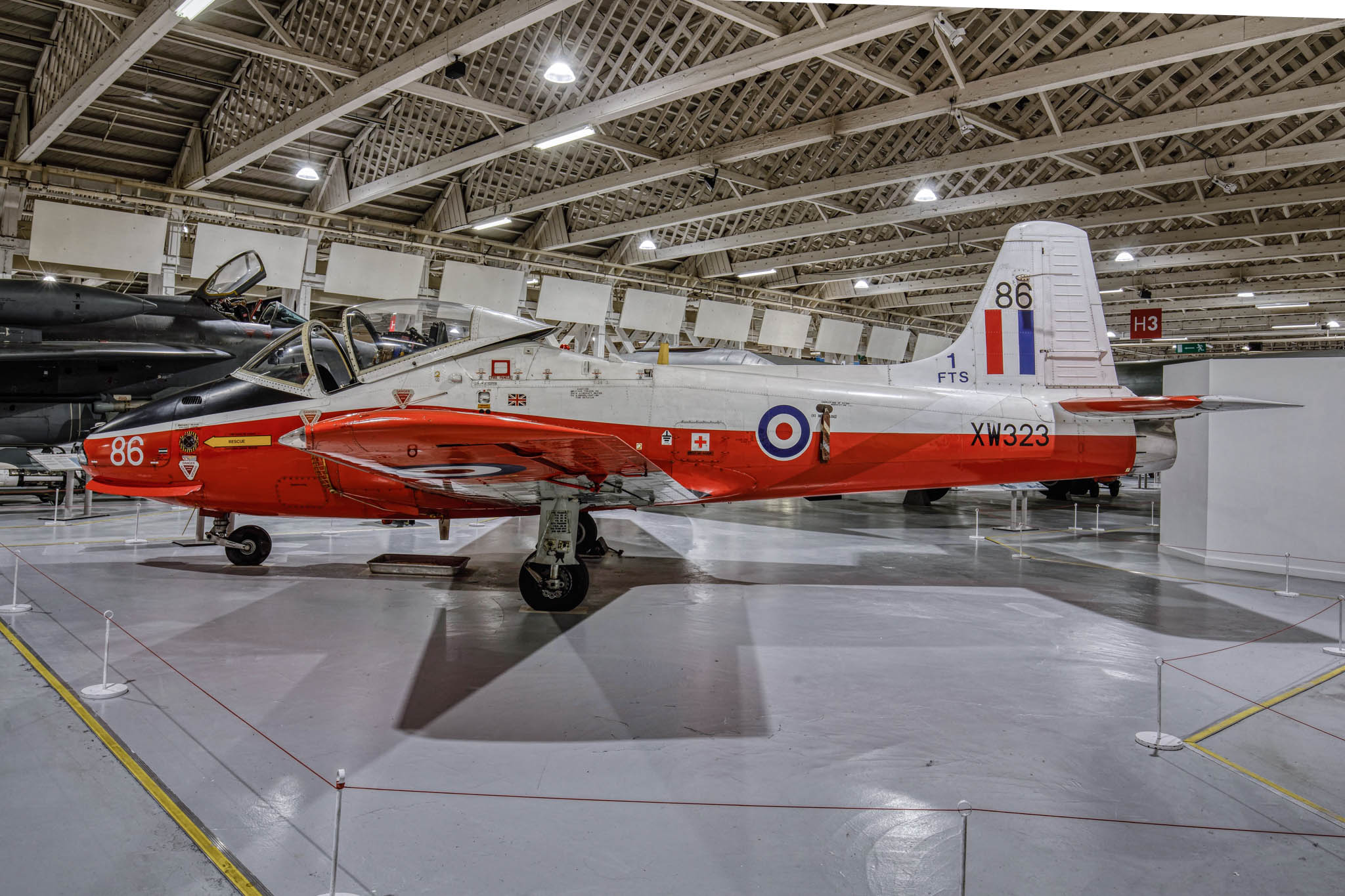 |
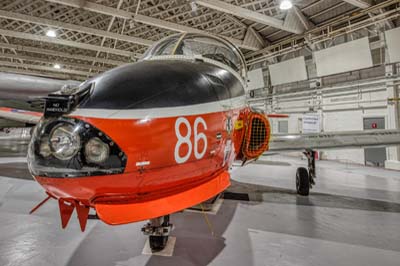 |
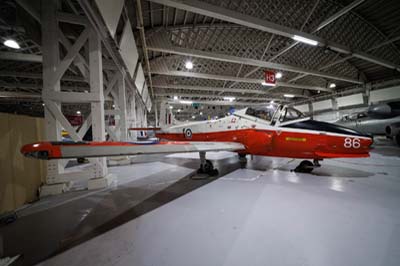 |
British Aircraft Corporation Jet Provost T.5A (XW323 '86' later 9166M). The Hunting Percival Jet Provost first flew in 1954 and was the first jet powered basic trainer to go into service anywhere in the world and was based on the piston powered Percival Provost. Ten T.1 variants were initially ordered followed by 201 T.3s which had an improved engine, an ejector seat and retractable tricycle undercarriage. 70 T.3s were later upgraded to T.3A standard with improved avionics. From 1961, 185 T.4s were delivered incorporating further improvements to the engine. The T.5 variant took to the air in 1967 and introduced the much needed pressurised cockpit. The first of 110 T.5s were handed over to the Central Flying School in 1969. 94 were later upgraded to T.5A standard between 1973 and 1976 with the introduction of improved avionics.
XW323 started its service life with the Royal Air Force College at Cranwell in 1970 and remained there apart from periods with 5 MU at Kemble till 1991, its final year was with 1 FTS at RAF Linton-on-Ouse before it was put on display in the RAFM in 1992.
Jet Provost T.3A (XM463 '38') was on display for cockpit experiences, it was moved to RAF Museum Midlands (Cosford) by February 2020. |
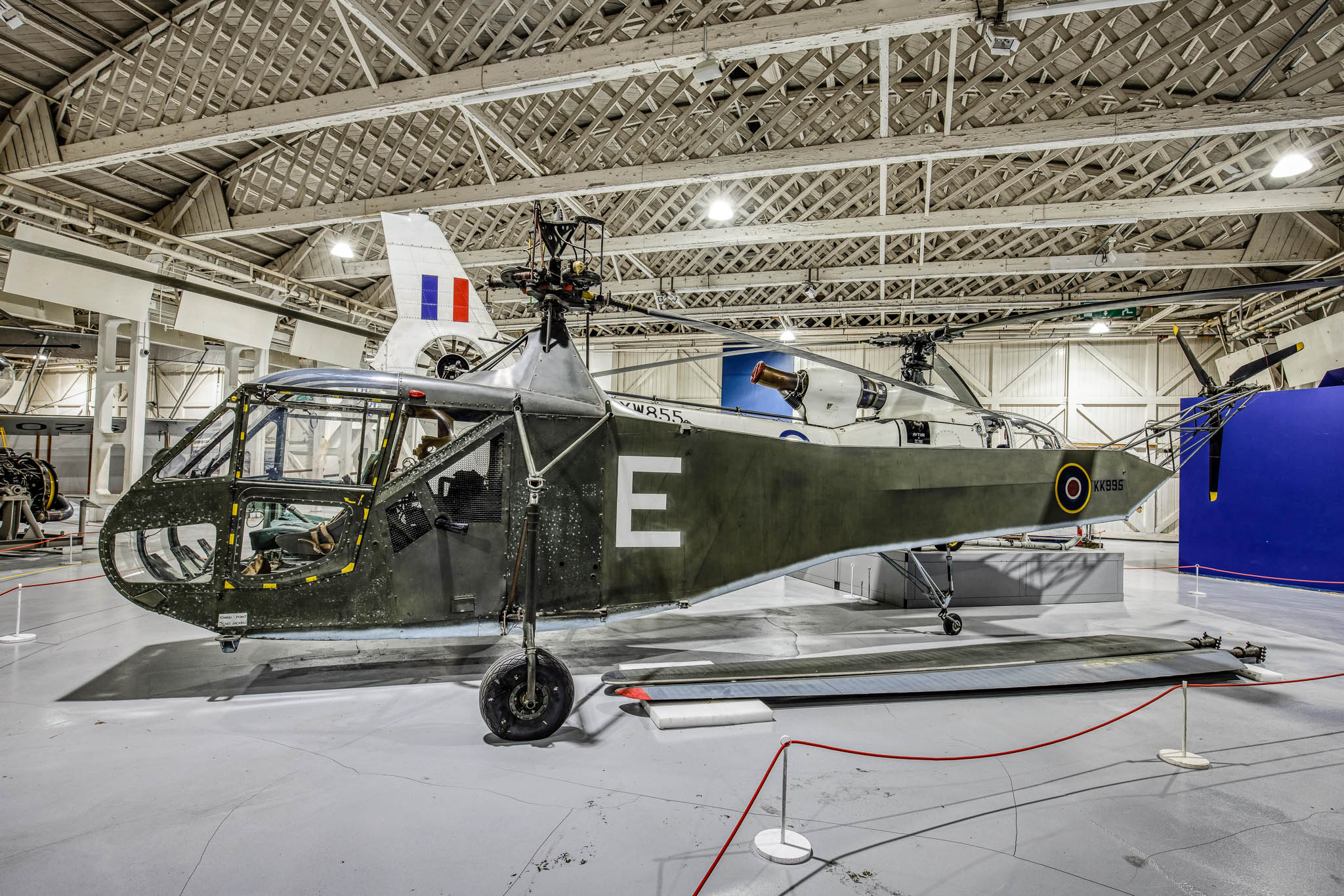 |
Sikorsky S-47 Hoverfly I (KL110 painted as 'KK995' 'E' ex 43-46558). 133 Hoverfly 1’s were built by Vought-Sikorsky in Stratford, Connecticut, 45 of which were supplied to Britain under lend-lease conditions in 1944 and 1945. The Hoverfly is credited with being the first operational helicopter in service with the RAF and the United States Army Air Force.
The Hoverfly on display is painted as KK995 but thought to be KL110 with parts taken from KK995. In 1945 KL110 was delivered to UK and assembled at Hooton Park, Cheshire. Later in the year at RAF Andover the 43 Operational Training Unit – Helicopter Training Flight was formed to train 29 Army pilots to fly the new helicopters. By 1947 KL110 was one of a number of Hoverflys allocated to the Kings Flight at RAF Benson, some of which were transferred to Scotland to operate the daily mail run to Balmoral Castle. The Hoverfly was withdrawn from RAF service in 1949 and some were evaluated by the Royal Navy till 1951. Both KL110 and KK995 found their way to the Cranfield College of Aeronautics for vibration testing. In 1966 they were offered to museums and KL110 was moved to Henlow with parts from KK995 for preservation and restoration as a composite from 1968. It was moved to Hendon in 1970 and suspended from the ceiling in the new Milestones building in 2003. |
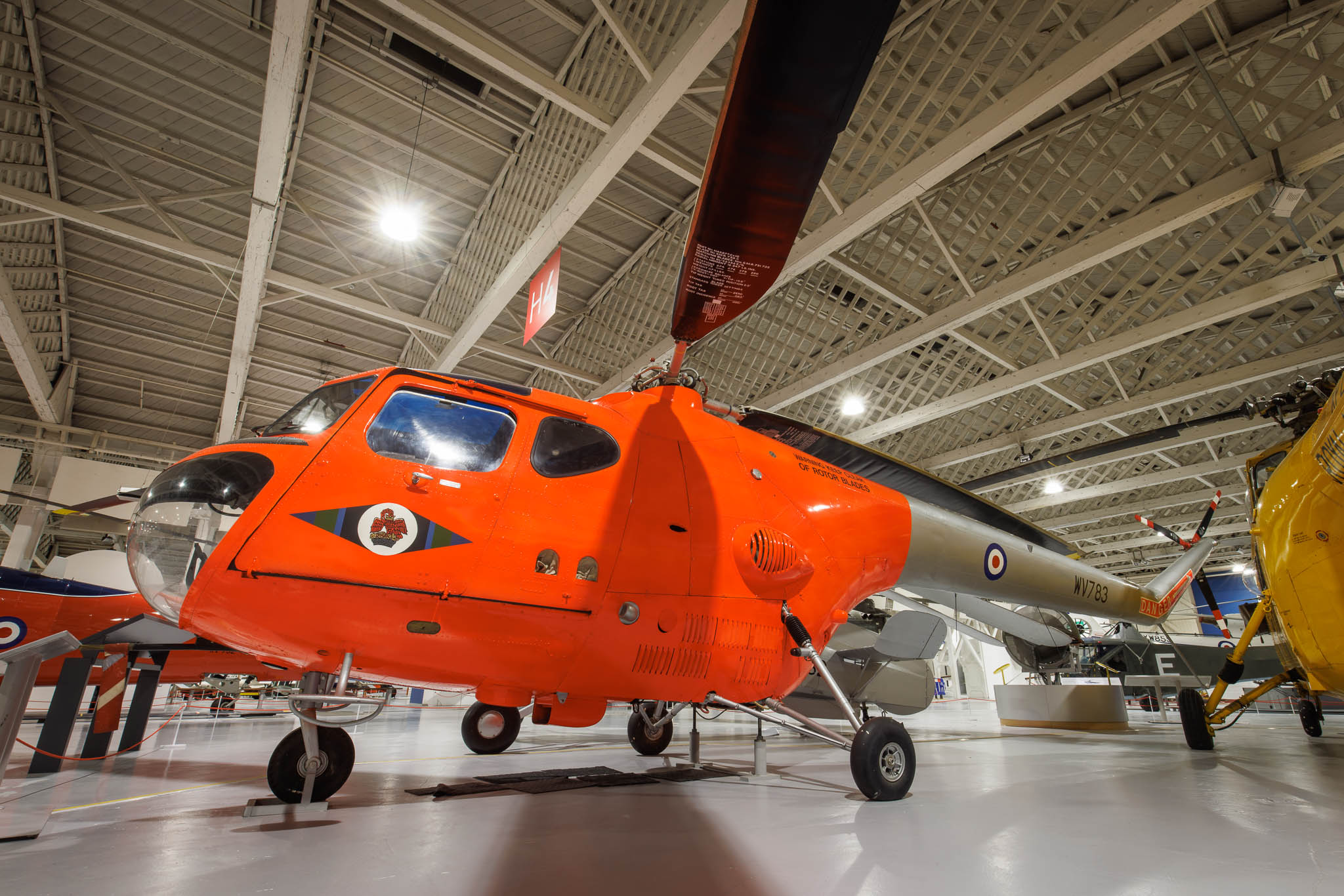 |
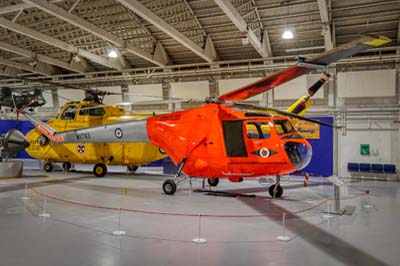 |
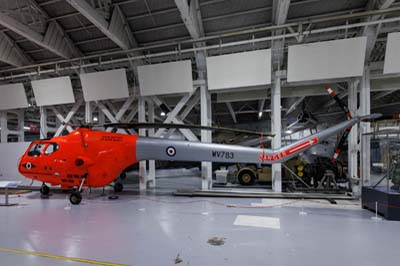 |
Left to right:
Bristol 171 Sycamore HR.12 (WV783 later 7841M and G-ALSP). The Sycamore is a single-engine five-seat light utility helicopter produced by the British manufacturer Bristol Aeroplane Company, it was the first British helicopter to serve with the RAF, it first flew in 1947. Built in 1950 four HR.12s were built for the RAF for evaluation in the search and rescue role. WV783 was put into storage (Old Sarum, Henlow, Cardington and Wyton) following an accident in 1953 arriving at Hendon in 2004 following its restoration in 2002 at Rochester. |
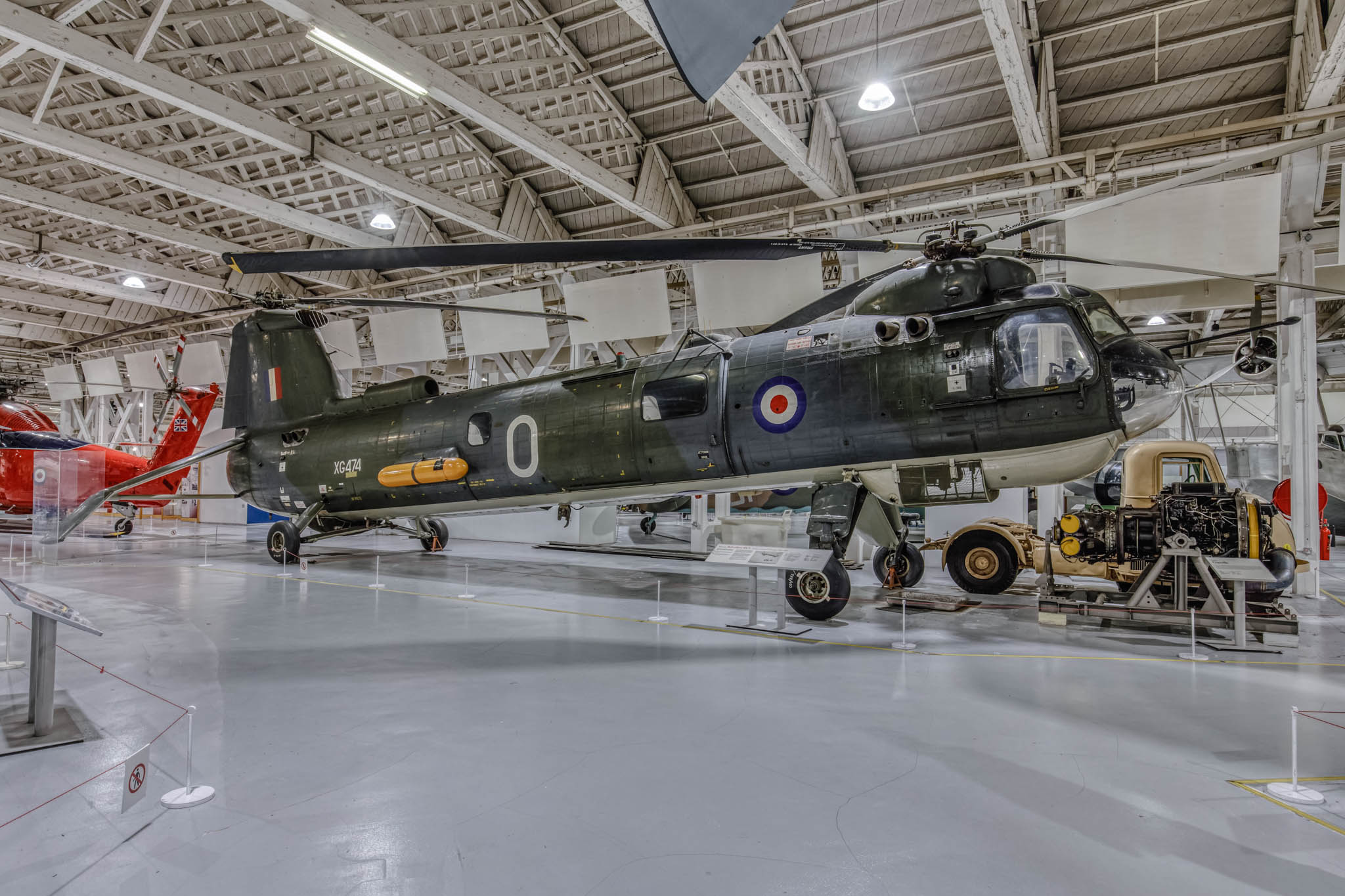 |
Bristol Type 192 Belvedere HC.1 (XG474 'O' later 8367M). Following its first flight in July 1958, 26 Belvedere's were delivered to the RAF from 1961. Till its retirement in 1969 they operated mostly in the Middle East and Far East.
XG474 was one of six shipped to Singapore in April 1962 for 66 Squadron at RAF Selatar. In 1963 it operated in Brunei and Borneo before joining 26 Squadron in Aden until they disbanded in 1965 when it returned to 66 Squadron in Singapore. When they disbanded in 1969 nine Belvederes were scrapped leaving XG474 which was shipped back to the UK for preservation. It arrived at RAFM at Henlow in August 1969 before moving to Hendon in 1971. |
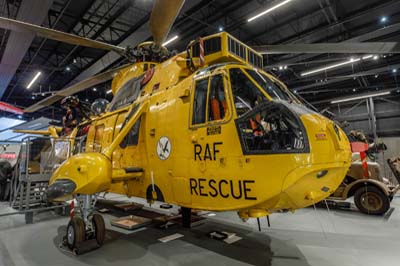 |
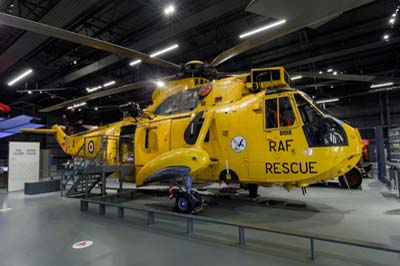 |
| Westland Sea King HAR.3 (XZ585 'A') British licence-built version of the American Sikorsky S-61. The initial batch of 19 (XZ585-XZ599) HAR.3 RAF Search and Rescue version entered service in 1978 to replace the Westland Whirlwind HAR.10. It had a stretched fuselage and inflatable buoyancy bags housed inside the aircraft's sponsons. XZ585 arrived at Hendon in December 2017 for the 'RAF First 100 Years exhibition'. |
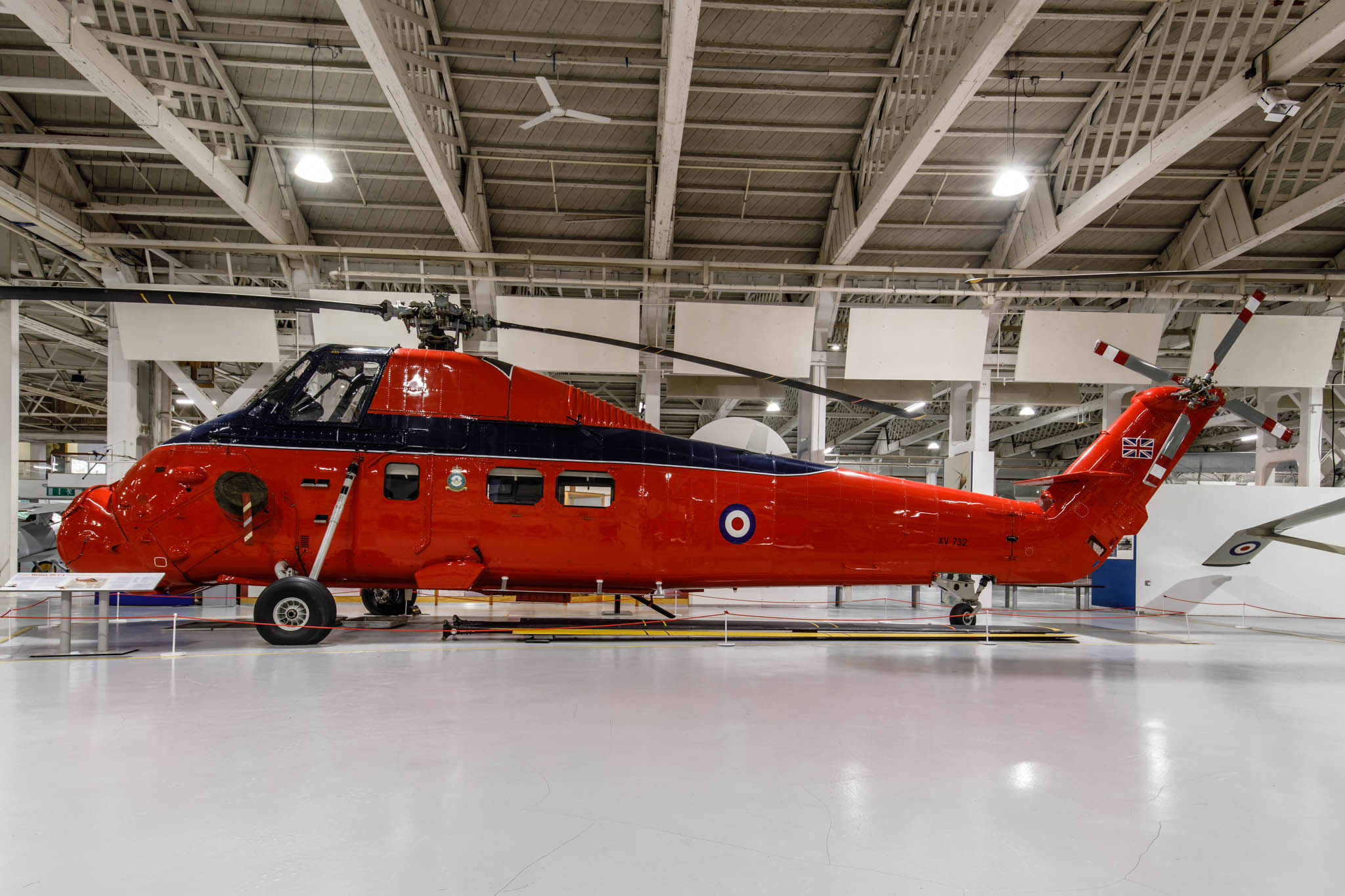 |
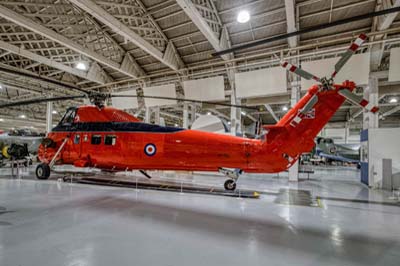 |
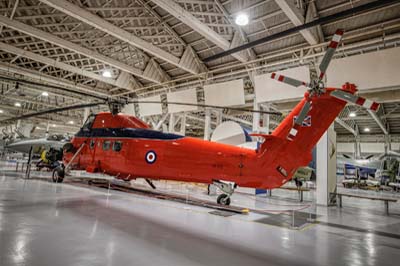 |
| Westland Wessex HCC.4 (XV732). The Wessex was a development of the Sikorsky S-58 and was produced at the Westland factory in 1956 at Yeovil initially for the Royal Navy with deliveries of HAS.1s commencing in 1958. In 1962 the HC.2 variant commenced deliveries to the RAF with 18 Squadron at RAF Odiham. In 1968 the Queen's Flight required two HCC.4s (VIP version of the HC.2) which operated from RAF Benson as 32 (Royal) Squadron until disbandment in 1998. XV732 was the penultimate Wessex built, its sister HCC.4 XV733 was the last Wessex built and also configured for service with the Queen's Flight. XV732 went to RAF Shawbury for storage until it was moved to the RAF Museum in 2002. XV733, the only other HCC.4 went to the Helicopter Museum at Weston-super-Mare in 2001. The last RAF Wessex flight took place in January 2003. |
| Exhibits on the move around the museum between October 2023 and November 2025 |
Left to right: Curtis Kittyhawk IV (A29-556 painted as 'FX760' coded 'GA-?' ex 42-106101).
Republic P-47D-40-RA Thunderbolt ('KL216' 'RS-L' also 9212M).
de Havilland Chipmunk (WP912) entered RAF service in 1950 replacing the Tiger Moth as an initial pilot trainer. The example on display was retired in 1974 and was transferred to Hendon and then on to Cosford in 1977. By November 2025 it had arrived here from Cosford for re-assembly. |
Left to right:
Hawker Typhoon 1B (MN235 '18-T').
Slingsby T.31B Cadet TX.3 (XA302). |
Left to right: Westland Wallace II (K6035 later 2361M).
Bristol Bulldog IIA (G-ABBB but painted as 'K2227').
Hawker Hunter FGA.9 (XG154 and 8863M). |
| These exhibits have been either transferred to the RAF Museum Midlands (Cosford), placed into storage, or removed from the museum's collection under a disposal plan. |
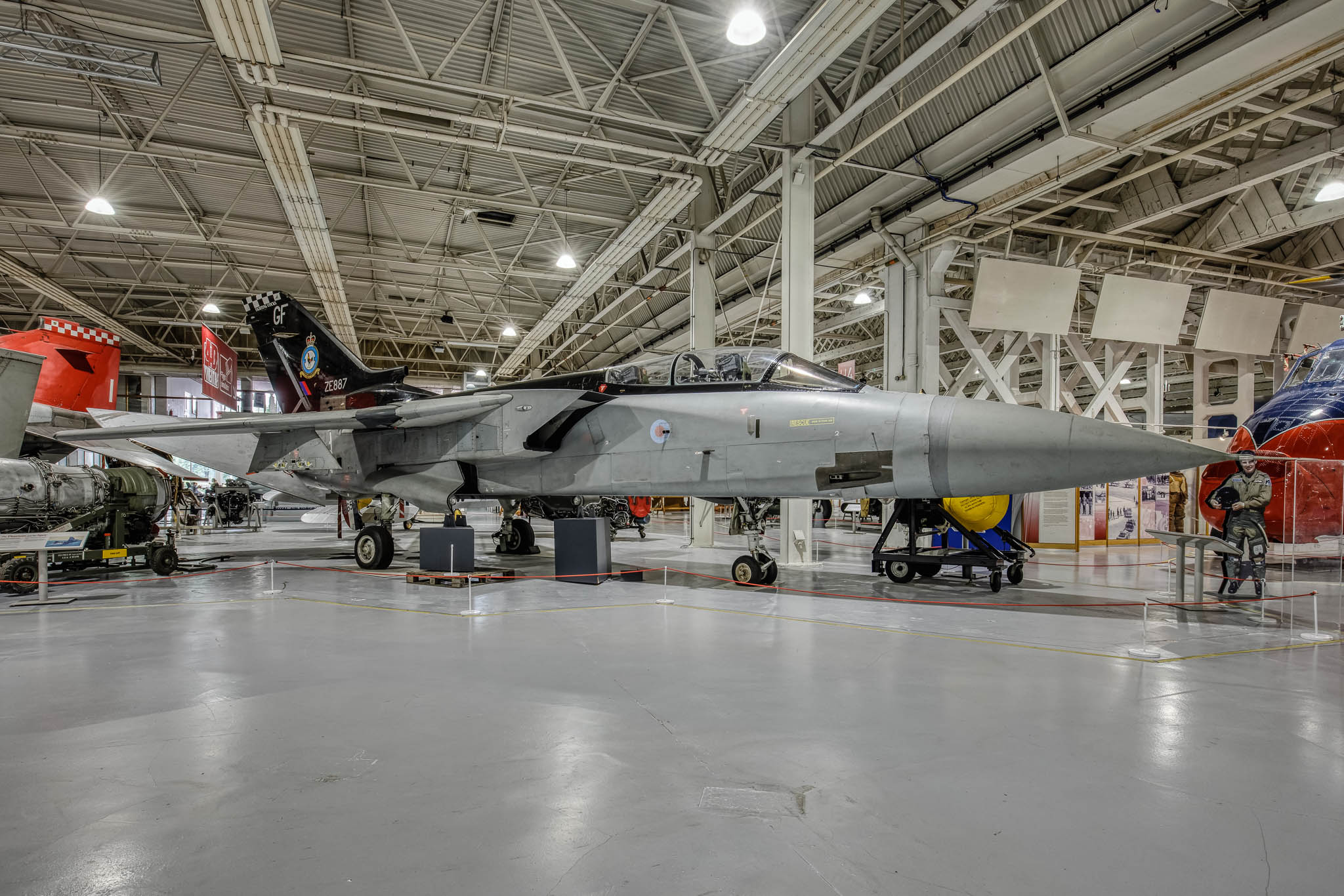 |
| Panavia Tornado F.3 (ZE887 'GF'). 152 Tornado ADVs (Air Defence Variant) started entering service from 1987. ZE887 first flew on September 30, 1988 and was delivered to the RAF in 1989 to 229 OCU at RAF Coningsby as 'AN'. By January 1990 it had become 'GF' with 43(F) Squadron. After periods with 11 Squadron and 5(AC) Squadron in 2005 it was painted with a black fin of 43(F) Squadron's Commanding Officer it has a specially painted tail fin with the code 'GF' which stands for the Squadron's motto; 'Gloria Finis' (Glory is the end). It was eventually withdrawn from service on March 4, 2010 having logged almost 5,000 hours. It was taken by road to St Athan on September 23 in preparation for preservation at the RAF Museum at Hendon. On October 18, 2010 it arrived at Hendon and was put on display on November 25, 2010. 15 years later it had been transported to RAF Shawbury for storage eventually leading to its display at RAF Museum Midlands (Cosford). |
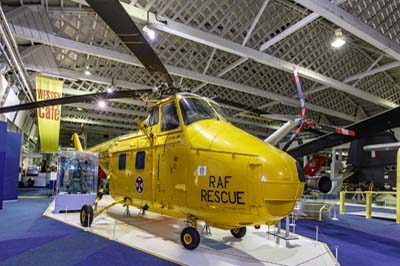 |
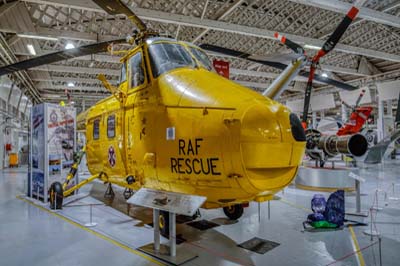 |
Westland Whirlwind HAR.10 (XP299 later 8726M). 68 Whirlwind HAR.10s were built and supplied for Search and Rescue (SAR) duties during the 1960s.
XP299 was built in 1961 by Westlands at Yeovil and was initially used for trials till it was delivered to Ternhill in 1966. In 1967 it was transferred to 230 Squadron at Odiham before its allocation to Finningley with 22 Squadron in 1971. It operated in the SAR role at Chivenor, Brawdy, Coltishall and Manston before its retirement in 1981 when it was presented to RAF Cosford Aerospace Museum. It was moved on to Hendon in 2003. By November 2025 it was back at Cosford. |
Westland SA.341E Gazelle HCC.4 (XW855). The Sud Aviation (later Aérospatiale) Gazelle was designed in France as a lightweight utility helicopter. In 1967 Westland Helicopters secured an agreement to build 292 Gazelles for all three services.
Built by Westlands at Yeovil in 1973 to SA.341D/HT.3 standard it was one of 32 Gazelles delivered to the RAF. It initially operated at RAF Turnhill as a helicopter pilot trainer but moved in 1976 to 32 Squadron at RAF Northolt, following modification to HCC.4 standard for the VIP communications transport role, it was the only HCC.4 conversion. The final flight took place in April 1996 after which it was put in storage at RAF Shawbury before being transferred to the RAF Museum in April 2003. It was no longer on display by November 2025. |
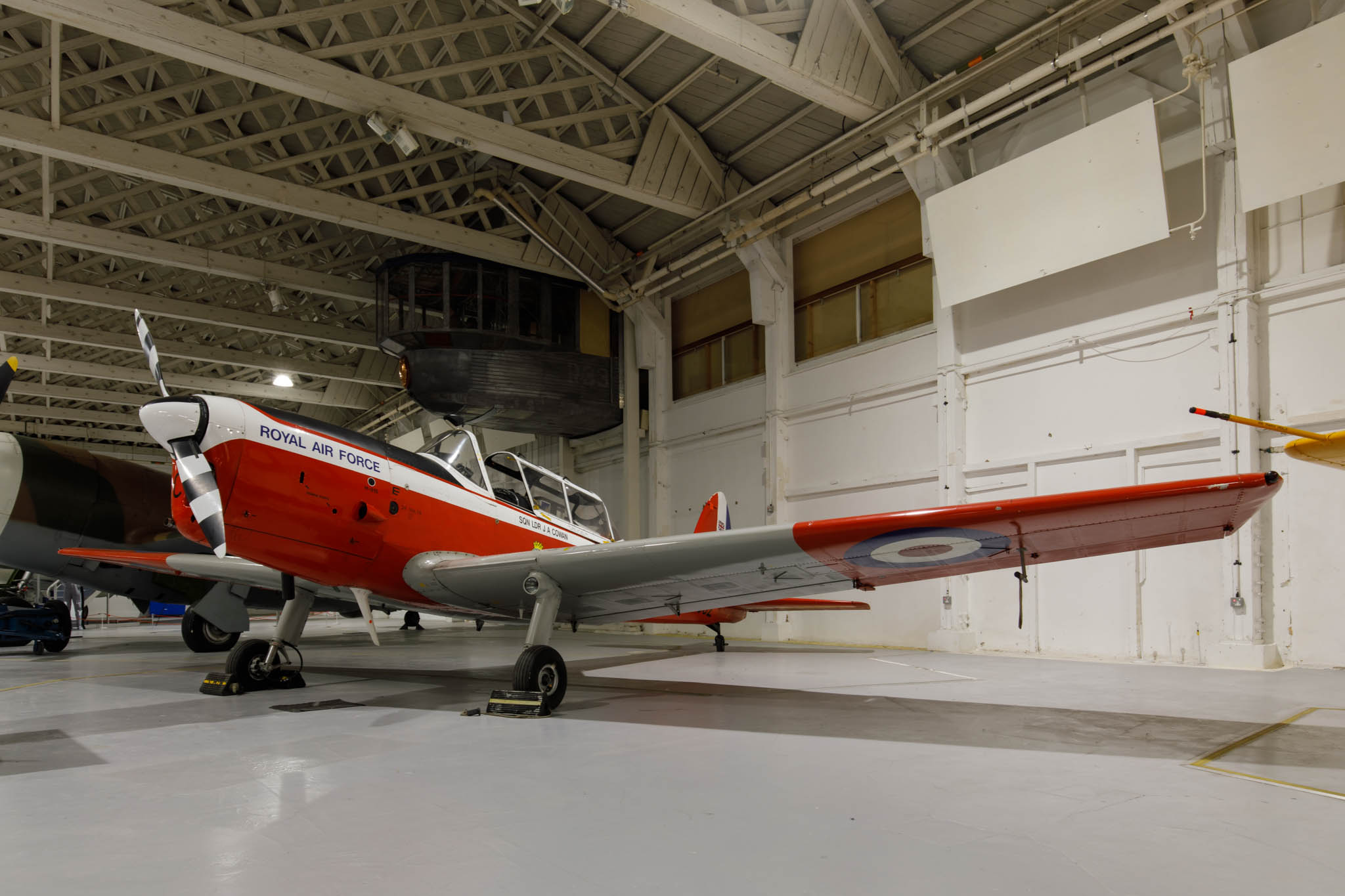 |
| de Havilland DHC-1 Chipmunk T.10 (WP962 'C'). Designed by de Havilland Canada eventually 735 examples were built. Replacing the Tiger Moth from 1950 the Chipmunk was the RAF's primary trainer, initially with the University Air Squadrons and later with the Air Experience Flights till the 1980s and beyond. By May 2025 it had been dismantled prior to its removel from the museum's collection as part of a disposal plan. |
Blériot XI ('164' also BAPC106 and 9209M). Designed by the French aviator Louis Blériot in 1909. The French, British and Italian air forces took delivery of 132 Blériot XI's from 1910. It was on display at the Milestones of Flight Exhibition in 2006. It is currently in the RAF Museum's store at Stafford.
Sopwith Pup (N5182 later 9213M). The Pup was in service between 1916 and 1918 as a single-seat scout-fighter, it had a top speed of 111 mph (179 km/h). The aircraft on display was built by the Sopwith Aviation Company at Kingston-upon-Thames, it was delivered to 8 (Naval) Squadron in September 1916. The Royal Naval Air Service squadron was then operating from Dunkirk before moving to Vert Galand. By the end of the year pilots flying N5182 were credited with three victories. In 1917 N5182 was transferred to 3 (Naval) Squadron before it was withdrawn from service in August 1917. By around 1960 she was found in the Musée de l'Air's reserve collection store and was moved to the United Kingdom for restoration. Thirteen years later and fully restored to flying condition it suffered a force landing on a delivery flight to Blackbushe in 1974. By 1982 the RAF Museum had acquired the aircraft for display. On display at Cosford by 2017. |
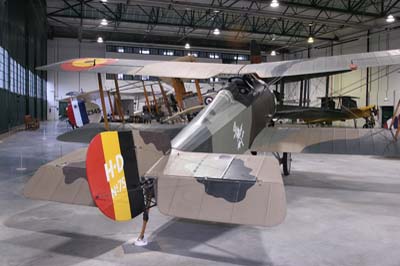 |
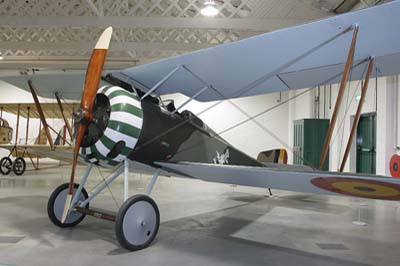 |
| Hanriot HD.1 (HD-75 of Belgian Air Force later G-AFDX and OO-APJ). The Hanriot-Dupont HD.1 was designed by Pierre Dupont and built at the Hanriot factory at Billancourt in France from 1916. At least 79 HD.1s were delivered to Belgium from 1917 (serials HD-1 to HD-79). (HD-78 is at the Brussels Museum). This aircraft served in the Belgian Air Force from 1918 at Les Moores and Nivelles. In 1922 it won the World Aerobatic Championships at Nice and was eventually withdrawn from service in 1933 and put up for sale. In 1937 it was purchased by Richard Shuttleworth and flown from Evere, Brussels to Old Warden and registered as G-AFDX. Following a landing accident in 1939 it was put into store at Old Warden and later Brooklands, where the wings were damaged beyond repair in a German bombing raid. In 1962 it was sold to Marvin Hand in San Francisco where he restored the aircraft. He presented the aircraft to the RAF Museum in 1978. After further restoration at Cardington it was moved to the Museum in 1979. It is now in New Zealand with The Vintage Aviator Ltd. |
Supermarine Seagull V (Royal Australian Air Force A2-4 registered VH-ALB). It was designed by R J Mitchell as an Air and Sea Rescue amphibian in 1933. It was used for rescuing downed airmen or for reconnaissance and could be catapulted from warships. It was known as the Walrus in RAF service, when the Royal Australian Air Force ordered 24 they named it the Seagull. With Supermarine concentrating on building Spitfires, production of the Walrus was assigned to Saunders Roe Ltd (SARO). SARO eventually built 461 out of a total of 746 aircraft by January 1944, when production ended.
The aircraft on display was test flown in December 1935 before its shipment to Australia. Before and during the war it was embarked on a number of HMAS ships suffering a number of accidents, including a sinking in 1938. After the war it was sold, becoming VH-ALB and operating successfully till the late 1960s. After a crash in 1970 it was held by the RAAF before being shipped to the UK in 1973. Restoration began in 1975 at Henlow and the aircraft was moved to Hendon. In 2017 it was dismantled and transferred to the RAF Museum Reserve Collection at Stafford. |
Miles M.12 Mohawk (G-AEKW ex HM503). One of a series of monoplanes designed by FG Miles, it was built and first flew in 1936 by Philips and Powis Aircraft at Woodley. The Mohawk was designed as a fast, long-range light touring aircraft for the famous American aviator Colonel Charles Lindbergh. He needed it for business trips around Europe with his wife Anne. The colour scheme of black and orange was chosen by Lindbergh for high visibility. It had to have adjustable rudder pedals as he was over six feet tall, with rear seats that could convert to a bed. Only one Mohawk was built. Handed over officially to Lindbergh in 1937 he then flew it via Italy to India. He returned via Serbia, Greece and Austria. In 1938 he flew to Russia via Germany, returning via Poland, Czechoslovakia, France and Holland.
Lindbergh presented the aircraft to the British Government at the outbreak of war for use as a communications aircraft. It survived the war after limited use, restored to the civil register in 1946, it was unfortunately written off in an accident in Spain in 1949. The wreckage was sold to the Granada Aero Club who intended to repair it, however by 1973 it was discovered in a scrap yard in 1973 near Tablada. In 1975 it was shipped to the Aeroflex Museum Foundation Collection at Santee, North Carolina for restoration. In 2000 it was presented to the RAF Museum and delivered to RAF Wyton later that year. Further restoration was done at Michael Beetham Conservation Centre at Cosford from 2002 until 2006. In 2008 it was moved to the RAFM for display in Milestones building. In January 2012 it was put into storage.
Gloster Gladiator (K8042). The Gladiator was the last biplane fighter when it entered service with the RAF in 1937. Unfortunately it was no match for the technologically more advanced German aircraft at the start for World War Two.
K8042 was delivered in 1937 and immediately went into storage. By 1941 it was put into service as the Station Flight at RAF Boscombe Down with the A&AEE. In 1942 it was transferred to 5(Pilots) Advanced Flying Unit at RAF Turnhill, before moving on in 1943 to 61 Operational Training Unit at RAF Rednal. Damaged in 1944 it went into storage at RAF Little Rissington until being struck off charge in 1948 but being retained for historical reasons. In 1965 it emerged from the RAF Museum store at Henlow to be restored in 1967 for display at the RAF's 50th Anniversary Royal Review in 1968. In 1971 it arrived at the RAF Museum at Hendon moving to the Battle of Britain Hall in 1978 and on to RAFM at Cosford by June 2018.
The forward fuselage wreckage of 263 Squadron Gladiator II (N5628) written off in 1940 in Norway when operating from a frozen Lake Lesjaskog has been on display at Hendon since 1972. |
| Hawker Hart Trainer (K4972). The Hart trainer was a two-seat advanced trainer and was in service from 1935 to 1944. The example on display started life at 2 Flying Training School at RAF Digby in 1935 before moving to 2 FTS at Brize Norton two years later. By 1938 it passed through various Maintenance Units and in 1943 it was transferred to 1546 Squadron at Wigton for instructional use. In 1962 the dismantled aircraft was found in a loft at Nelson Thomlinson School in Wigton, by Solway Group of Aviation Enthusiasts. Following a brief period of display at Carlisle Crosby airport it was presented to the RAF Museum and put in to store at Henlow a year later. In 1968 it went to St Athan for restoration and display. In 1972 it was put on display at Hendon and in 1987 further restoration was carried out at Cardington prior to its move to Cosford for display in 1992. By 2002 it was back at Hendon and later at Cosford by 2018. |
Left to right:
de Havilland DH.60M Gypsy Moth (G-AAMX ex NC926M). de Havilland designed the Moth from the 1920s as an aircraft to meet the needs for the fast growing aero clubs and private pilots. In 1926 they re-engine the Moth with the new de Havilland Gypsy engine. The RAF flew 134 Gypsy Moths up until 1939 when they had all been retired. However, at the start of the war 146 civilian owned Moths were impressed into service by the RAF for communications duties.
G-AAMX is one of 29 DH.60M Moths built by Moth Aircraft Corp. at their St Louis factory from 1928. It was sold to Plymouth Airways, Plymouth, New Hampshire as NC926M on July 1930, but was written off in a crash on August 7, 1930. From 1930 till 1983 it was stored by a number of owners till it was bought by Cliff Lovell who shipped it to the UK and stored it initially at Walkeridge Farm. John Parkhouse later bought the damaged aircraft and started a 2,000 hour restoration project to return it flying condition which was completed by 1987. A previously unused period registration was obtained and it was moved to Shoreham. Following the death of John Parkhouse in 1993 and after 127 post restoration flights, its C of A expired in 1994. It was donated by the family to the RAF Museum and moved to Cosford in 1996 and later to Hendon in 2003. In January 2012 it was put into storage at RAF Stafford and is up for disposal.
de Havilland DH.82 Tiger Moth (T6296 later 8387M). The Tiger Moth was used by Elementary Flying Training Schools (EFTS) from 1932 to 1951. This example started its military service with 1 EFTS in 1941 and later 7 EFTS in 1942. At the end of the war it was transferred to the Fleet Air Arm and was in use at a number Royal Navy Air Stations until 1966. Following a period of storage at RNAS Fleetlands its was transferred to RAF Henlow in 1972 for the RAFM later in the year. In 1990 it was moved from the Main Hall to the Battle of Britain Hall. In 2016 it was transferred to Cosford. |
Percival Prentice T.1 (VS618 registered G-AOLK). 349 Percival P.40 Prentices were built at the Blackburn Aircraft factory at Brough, deliveries were from 1947 to 1949. The Prentice was the first side by side trainer in the RAF and were in service as trainers until 1953 and were retired during 1956. 252 examples were offered to the civilian market, however due to excessive fuel consumption only a few were sold the rest were scrapped.
The example on display was sold in 1961 and after periods of storage was eventually bought by RAFM in 2009 and restored to its former 22 FTS colours. Only 17 Prentices exist today. It is now in the RAF Museum Reserve Collection at Stafford. |
CASA 1-131E Jungmann (E.3B-521 '781-3'). The aircraft of display was formally with Spanish Air Force (Ejercito del Aire) and was licence-built version of the Bücker Bü-131 Jungmann by Construcciones Aeronauticas S.A. (CASA) of Spain. Production continued in Spain until the early 1960s and it flew with the Spanish Air Force till 1968. The Bu-131 was designed as a primary trainer in 1933, taking to the air a year later. The Jungmann was also licence-built in Hungary, Czechoslovakia and Japan.
This aircraft was acquired by the Museum in exchange for a Cierva C.30 Autogiro, as an example of German training aircraft to compliment the impressive collection of fighters and bombers. This particular E.3B was built in the 1950s by CASA in Spain. It served with 781 Squadron till the early 1980s. They were finally put into storage at Granada where I was fortunate to see a hangar full of these fine aircraft in 1982. Currently in storage with the RAF Museum Reserve Collection at Stafford. |
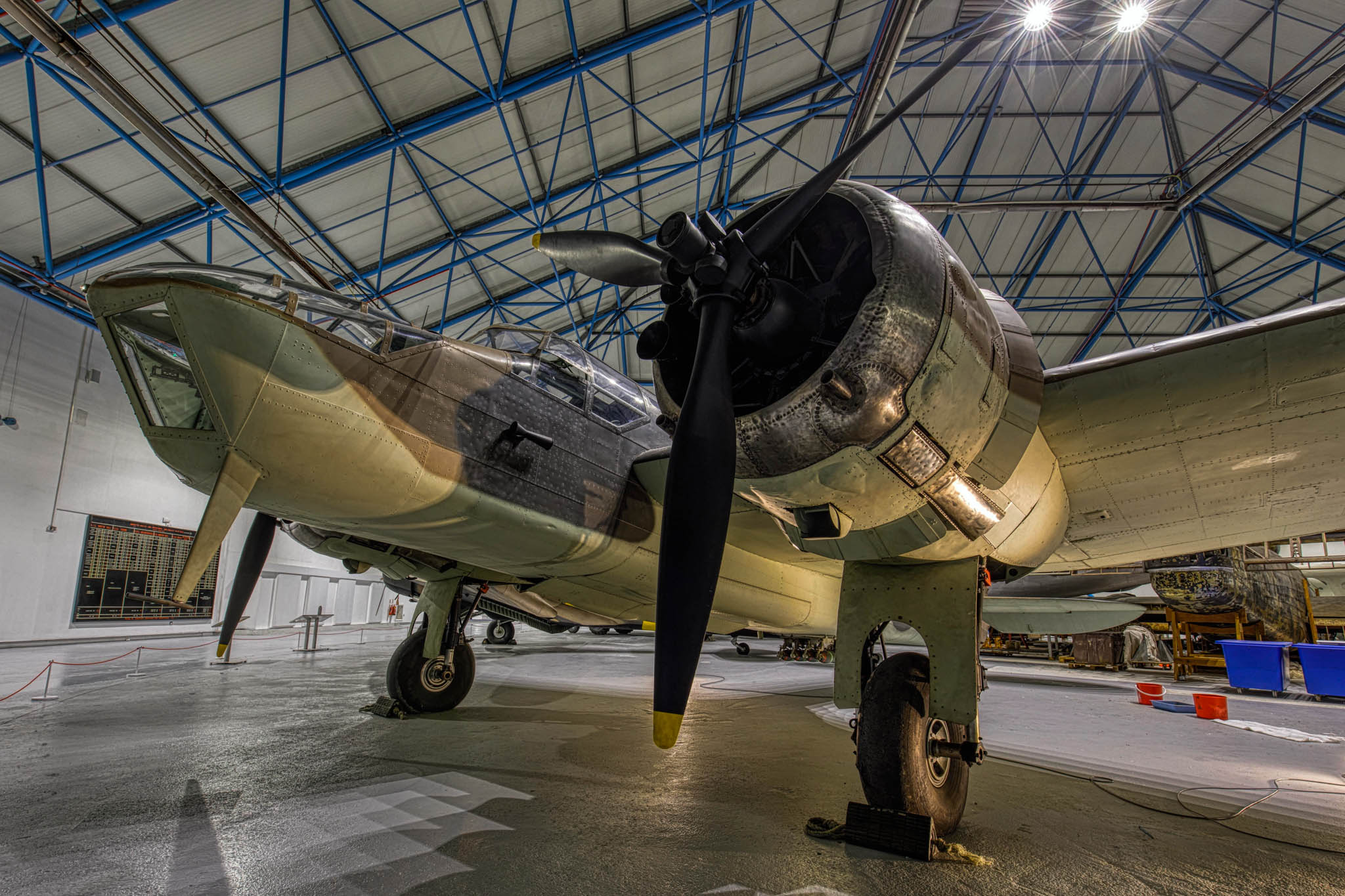 |
Bristol Bolingbroke IVT ('L8756' really ex RCAF 10001). The Bristol Blenheim was developed in 1936 as a light bomber. The Blenheim I was superseded by the Blenheim IV in 1938 which was fitted with a longer nose. They were used for day and night bombing raids on occupied ports till 1941 and some were converted to night fighters but had little success due to their lack of speed. Some Blenheim IV's served in North Africa and in the Far East.
The Bolingbroke IV on display was license-built by Fairchild Aircraft in 1941 and delivered to the Royal Canadian Air Force in 1942. After serving with Bombing and Gunnery Schools in Canada it was struck off charge in 1946 and sold to a private owner. It was eventually purchased by the RAF Museum in 1966 and moved to Henlow in 1969 for storage. Restoration began in 1972 by the A&AEE at Boscombe Down and was completed in 1978 and it was transferred to Hendon later in the year. It is painted as 'L8756' to represent an aircraft from 139 Squadron. It was transferred to RAF Museum Cosford in November 2022. |
Vickers Wellington T.10 (MF628 later 9210M). Using a very strong geodetic type of construction developed by Barnes Wallis, the Wellington went into service in 1938. Designed as a long range bomber, it was also found to be an effective torpedo carrier with Coastal Command. By 1941 four-engine bombers were introduced and the Wellington was transferred to Transport and Training Commands.
The example on display was delivered to the RAF in 1944 as a Wellington 10. In 1948 it was converted to a T.10 and transferred to 1 Air Navigation School but suffered an accident in 1951. Following repair it was sold back to Vickers in 1955 who presented it to the Royal Aeronautical Society. In 1964 it was placed on permanent loan to the RAF moving to Hendon in 1971. A front gun turret was fitted in 1981. In 2010 it was moved to Cosford for restoration. |
Boulton Paul Defiant I (N1671 'EW-D' later 8370M). The Defiant entered service in 1939 as a two-seat turret armed fighter. Unfortunately, the concept of a rear facing turret and no forward facing guns was not very successful. After suffering considerable losses in daylight its operations were switched to night-time. Despite adding radar to improve its effectiveness, the Defiants were withdrawn in favour of Beaufighters and Mosquitos.
N1671 entered service in August 1940 with 307 Zwowski (Polish) Squadron at RAF Kirton-in-Lindsey and later at Blackpool, Colerne and Exeter. After transfer to 153 Squadron at Ballyhalbert and 285 Squadron at Honily in 1942 it was withdrawn from service in 1943. Following periods of storage at various airfields it ended up at St Athan in 1960 before moving on to Finningley in 1968. It was transferred to Hendon in 1971 and moved to the Battle of Britain Hall in 1978. It was no longer on display by December 2009 having moved to Cosford in 2018. |
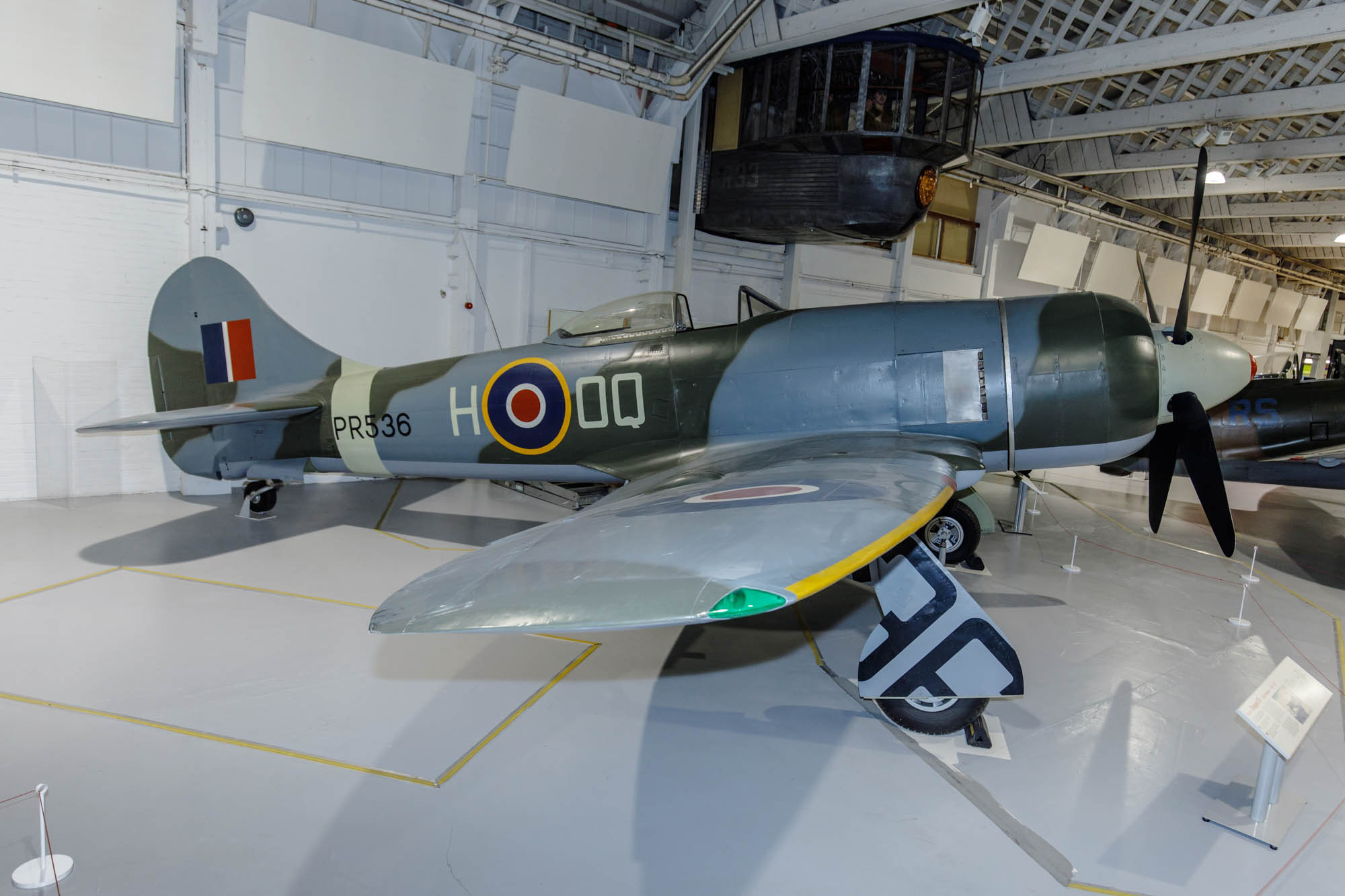 |
Hawker Tempest II (PR536 'OQ-H' and formally Indian Air Force HA457). In 1940 Hawker's Sydney Camm, was at work designing a successor to the Typhoon. The result was the sleeker Tempest, which took to the air in February 1943. 3 Squadron, converting from the Typhoon, were the first squadron to go operational in April 1944. It was soon found to be more superior than its German adversaries in their Bf 109s during the D-Day landings. They were also used to intercept the V-1 flying bombs, destroying around 800 by August 1944. More than 1,400 Tempests were built and only twelve survive today, two of those are at Hendon. In January 2020 it was moved to the RAF Museum at Cosford.
This Tempest II (PR536) was built in 1945 by Hawker Aircraft at Langley and was shipped to India. After the war in 1947 it was one of 124 that were given to the Indian Air Force. It ended up as a decoy at Poona by 1969. It was brought back to Great Britain in 1979 and eventually went into storage at Cardington in 1987. Following restoration at Duxford it was put on display at Hendon in November 1991 in 5 Squadron colours. |
| Hawker Tempest II ('PR536' 'OQ-H' and formally Indian Air Force HA457). Partly dismantled in readiness of its transfer to Cosford in January 2020. |
North American B-25J Mitchell (44-29366). The prototype first flew in 1940 with initial deliveries commencing in the following year. The Mitchell was also delivered to the RAF, the Dutch and Russian Air Forces.
This actual aircraft was delivered in 1944 but did not see any operational service, but was used for training from 1946 to 1959. Following a film career ('Catch 22' and 'Hanover Street') it joined the RAFM in 1982. It is painted in the scheme applied to it on delivery.
In May 2022 it was dismantled ready for departure to the Lincolnshire Aviation Heritage Centre in East Kirkby which was completed in November 2022. |
Junkers Ju 88R-1 (360043 'D5+EV' later PJ876 and 8474M). The Ju 88 was one of the most versatile and successful German aircraft of World War Two. It was employed as a bomber and later as a night fighter and also for long-range reconnaissance. The first Ju 88As were delivered in September 1939, they were immediately used to attack British shipping and later for the Battle of Britain. Insufficient defensive armament meant that they suffered heavy losses before their role was switched to night-fighting.
The example on display was license-built by Heinkel in 1942 and was converted to R-1 standard in 1943. On May 9, 1943 it took off from Aalborg in Denmark landing at Kristiansand in Norway. After falsely reporting that it had an engine fire it headed for Scotland. British Secret Service had somehow previously convinced the German aircrew (Oberleutnant Heinrich Schmitt, veteran of the Spanish Civil War and the Battle of Britain, radar operator Oberfeldwebels Paul Rosenberger and mechanic Oberfeldwebels Erich Kantwill), to defect and fly the aircraft to Great Britain with its radar secrets. It landed at RAF Dyce at Aberdeen to be met by Professor RV Jones a German radar expert. It was flown to RAE Farnborough a few days later under escort for evaluation and testing. British markings were applied and it was transferred to 1426 (Enemy Aircraft) Flight. At the end of the War the Flight was disbanded and the Ju 88 was transferred to RAF Sealand with 47 MU, destined for a museum. It passed through several other airfields and storage, before going to St Athan in 1973 for restoration. Restoration was completed in 1975 and it was moved to Battle of Britain Hall at Hendon in 1978. Moved to Cosford by 2018. |
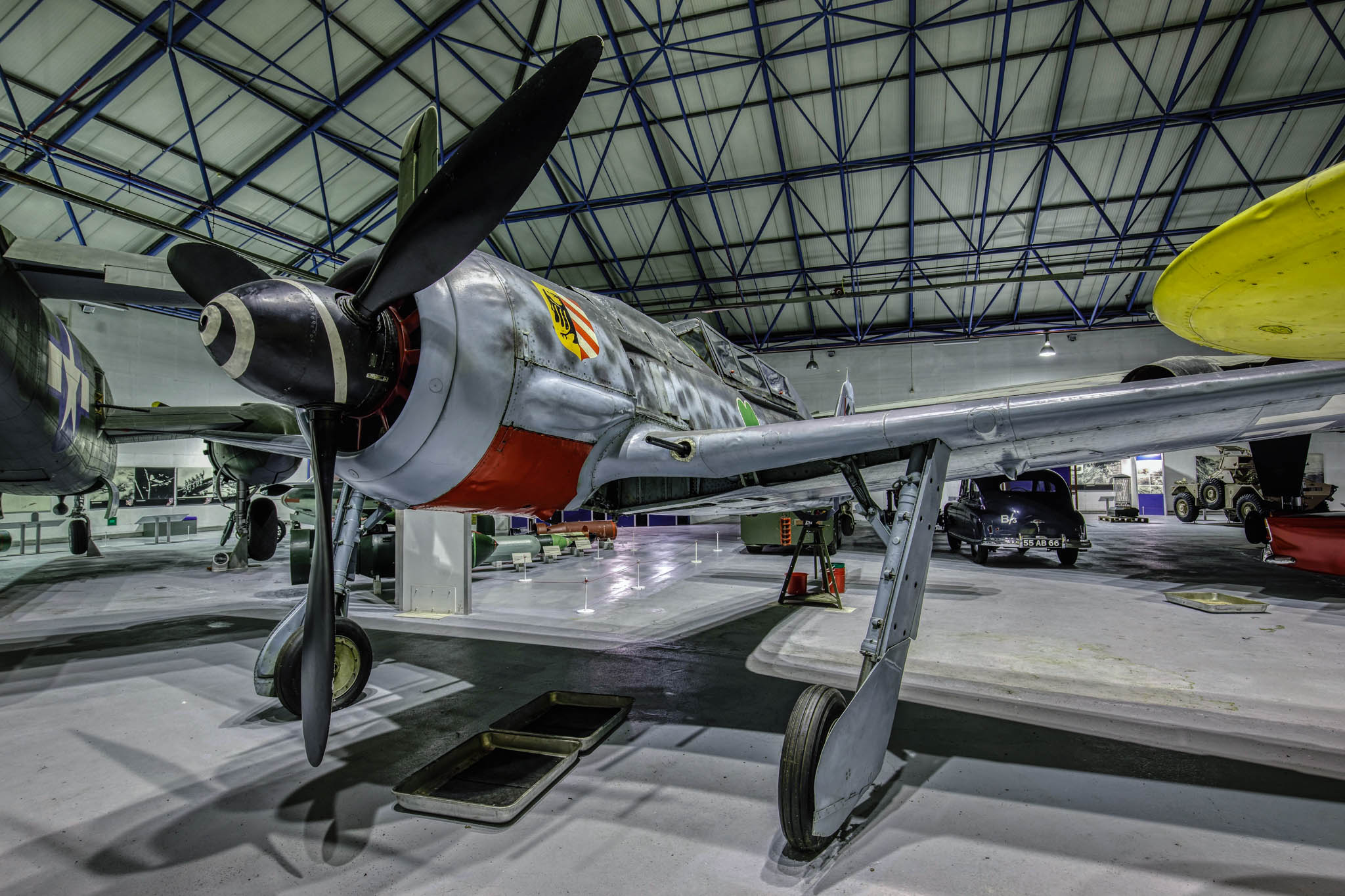 |
Focke-Wulf Fw 190A-8/U1 (584219 '38' later 8470M). The Fw 190 operated very successfully from its introduction in 1941 and throughout the war, as a day fighter alongside the Messerschmitt Bf 109. Built in 1944 as a standard single seater F-8/U1, in late 1944 she was converted to two-seat trainer. It was at one time with the Air Fighting School 103. It was found in Northern Germany and flown to the Royal Aircraft Establishment at Farnborough for evaluation at the end of the war. Selected for preservation by the Air Historical Branch, from 1946-1970 she would spend time in storage or placed on static display at various RAF base open days. In 1970 it was moved to RAF St Athan to join the Historic Aircraft Collection and by 1984 her BMW 801 D-2 was restored to ground running condition. In 1989 it was placed on static display in the RAF Museum, Hendon.
Dismantled in March 2022 ready for long-term loan with the Militärhistorisches Museum der Bundeswehr in Berlin-Gatow. |
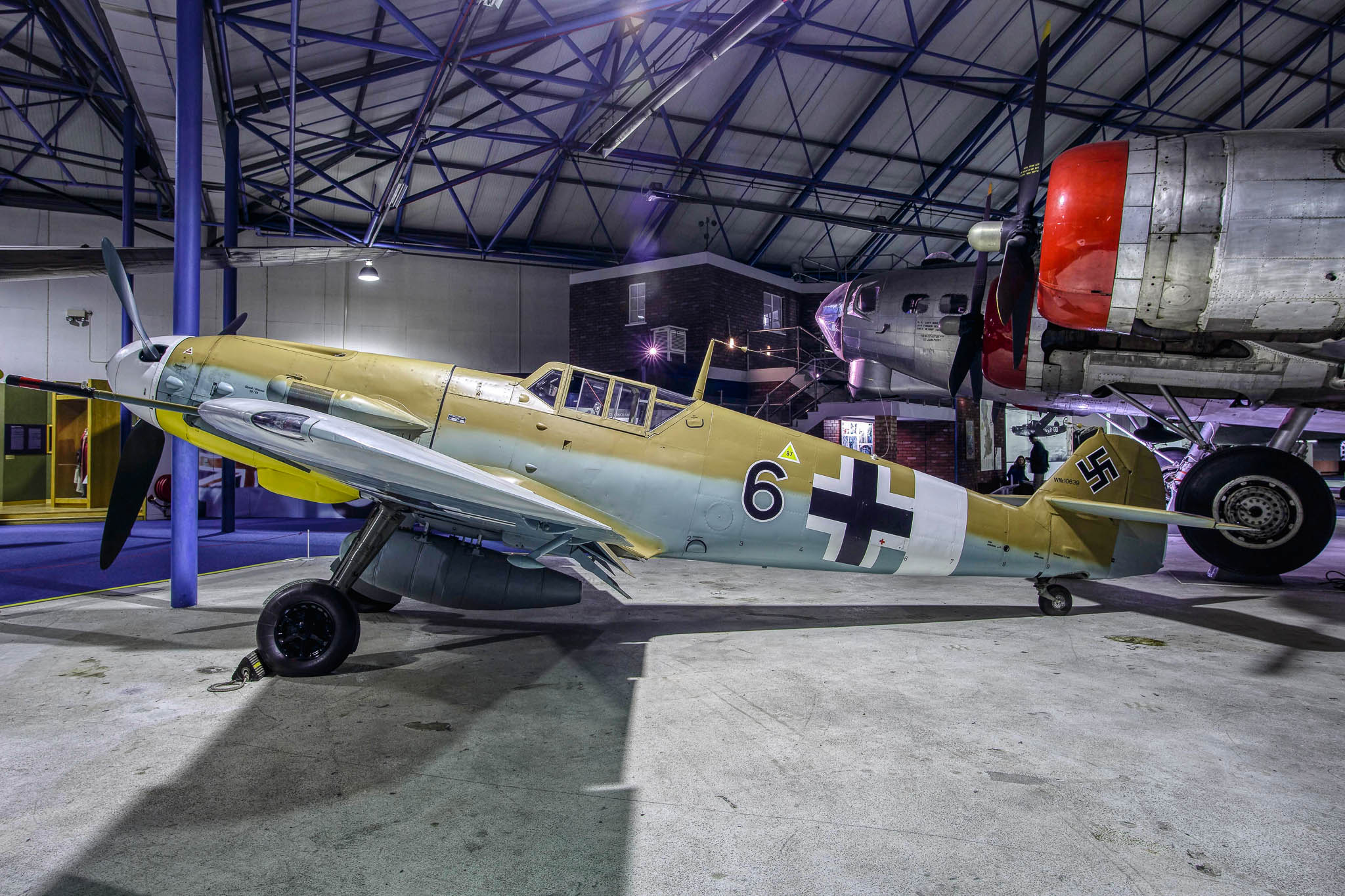 |
| Messerschmitt Bf 109G-2 (10639 'Black 6' later RN228 and 8478M and G-USTV). The Bf 109 was one of the finest single seat fighters from World War Two with 33,000 being produced. It was designed in 1935 and performed very well during the Spanish Civil War. It was only matched by the Spitfire's and Hurricane's performance. It could out climb both and was faster than the Hurricane but not the Spitfire. Its main limiting factor was its limited endurance as it could only engage in combat over England for a few minutes. A fighter-bomber version was introduced in 1940. In January 2012 it was moved to the Bomber Command Hall and by June 2018 it had moved to Cosford. |
Messerschmitt Me-262A-2a Schwalbe 'Swallow' (112372 'Yellow 4' later VK893 and 8482M). This was the most advanced fighter of World War Two. Design work began in 1938 but problems with the revolutionary turbojets delayed the first flight till July 1942. An interfering Hitler insisted that it be manufactured as a fighter bomber and as such it was not operational till summer 1944. As a fighter the Me262 was formidable but the small numbers produced meant that it had little impact during the war.
On May 8, 1945 four other Me 262s of JG7 flew from Zatec, Czechoslovakia to Fassberg in northern Germany to surrender to British forces. This Me 262 may have been one of these found at Fassberg. Another source suggests it could have been found at Schleswig. What is known is that 112372 was flown from Twente, Netherlands in June 1945 and was ferried to RAE Farnborough later in the month for the RAE Aerodynamics Flight. By 1947 it was with RAF College Cranwell's Station Museum when this museum closed it was transferred to RAF Gaydon in 1968 where it was repainted for display. It was later moved to RAF Cosford in 1976 where in 2003 it was repainted as 'Yellow 4' for display at Hendon in the Milestones of Flight Exhibition before moving to Cosford by 2018. |
Gloster F.9/40 Meteor Prototype (DG202/G later 5758M). This is one of eight Meteor prototypes ordered by the Ministry of Aircraft in February 1941. It was built by Glosters at Brockworth by Autumn 1941. Following ground running tests it attempted to take to the air in July 1942, but was beaten by sister aircraft DG206 to a first flight. Its actual first flight took place in July 1943. Trials continued until 1945 including deck landings before it was put into storage with Glosters at Moreton Valance and was later allotted the instructional maintenance serial 5758M with School of Aeronautical Engineering (Officers) at RAF Henlow at the end of 1945. There it was used for ground training until it was transferred to the main gate at RAF Yatesbury in 1958. In 1965 after a period of storage it moved to RAF Cosford where it remained until its transfer to RAFM Hendon in September 2011. DG202 had been put into storage in Lamella Hangar 9 at Cosford by February 2018. As photographed at Cosford in 1989.
Saunders-Roe (SARO) Skeeter AOP.12 (XM555 later 8027M). Designed by Cierva from 1948 development continued by Saunders Roe from 1951, when they were taken over. The Skeeter was the first helicopter to operate with the British Army Air Corp (AAC). Eventually 64 AOP.12 variants were produced for the AAC and delivered from 1958 to replace the Auster in service. It was later replaced by the Sioux and Scout from 1967.
XM555 was built at the Eastleigh factory and delivered in July 1959 to the AOC at Middle Wallop, before transfer to 654 Squadron at Hildesheim, West Germany. It later went to Osnabruck before its retirement in 1968 when it went to RAF Upwood as a Ground Instructional airframe (as 8027M). From 1973 it was displayed on the gate at RAF Ternhill and then RAF Shawbury from 1977. Restored in 1983 it was transferred to RAFM at Cosford and later to Hendon in 2003. It had been removed from display by December 2013 and transferred to the North East Land, Sea and Air Museum in Sunderland.
European Helicopter Industries Merlin EH101 (ZJ116 registered G-OIOI). The Heliliner was a prototype civilian passenger design which was not successful. From April 1990 for flight-tests and trials it was flown with a military serial. It arrived at the museum in November 2002. |
| Slingsby Grasshopper TX.1 (WZ791 later 8944M). 152 Slingsby Grasshoppers were built at Ings Lane, near Kirbymoorside, Yorkshire for the Combined Cadet Force and Air Training Corps from 1952 to 1953. They were used for ground training and with a rubber bungee for ground slides to develop a cadet's self-discipline, leadership and as an introduction to RAF procedures. Some Grasshoppers remained in use until 1986 when structural defects were discovered. This example was transferred from the Air Cadet Central Gliding School at RAF Syerston to RAFM Hendon in 1991 after it had been on display for a period. It is displayed suspended from the ceiling in the entrance hall, however it was removed in December 2022 and replaced with the Cierva C.30A (K4232). |
Left to right:
BAE Harrier GR.3 (XZ997 'V' later 9122M). This example was first allocated to 4 Squadron at Gütersloh with RAF Germany in 1982 and later that year moved to Yeovilton for ski-jump training prior to being involved in the Falklands War on HMS Hermes. After the war it returned to 4 Squadron at Gütersloh before a spell with 1435 Flight for the Air Defence of the Falklands. In 1986 it was with 1 Squadron and 233 OCU at Wittering. From 1988 to 1989 it was back with 4 Squadron before it was withdrawn from service and transferred to St Athan for storage making its final flight with a total of 2,200 hours and 6,050 landings. In 1991 it was allotted to the RAF Museum at Hendon. In 2003 it was put on display in the new Milestones of Flight Building. By 2019 XZ997 was on display at Cosford, before its move to Hendon. It was back at Cosford on display by 2022.
Hawker Hunter FR.10 (853 (Jordan & Oman) previously XF426). XF426 was delivered to the RAF in 1955 as a F.6 variant of which 379 were built. It initially served with 208 Squadron in Cyprus before being recalled in 1959 for conversion to FR.10 standard. From 1965 it was used by A&AEE at Boscombe Down for camera trials before moving to 2 Squadron at Gutersloh in West Germany in 1967 and then to 229 OCU later in the year. In 1972 it was given to Jordan before moving on to Sultan of Oman in 1975 serving until 1993. After years of static display it was transferred to the RAFM in 2003. It was placed around the back of the museum for a while before being mounted on a plinth at the front in 2010. It left Hendon in March 2017 arriving by Cosford in 2021 and stored outside behind the hangars. |
Photography Note:
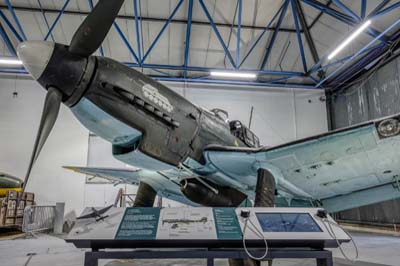 |
From around 2021 computerised information stands were placed in front some of the exhibits. Whilst for those seeking a lively interactive information source they are a useful addition, they go a step further to making unobstructed photography almost impossible. |
This is not a museum I have visited very often before I went digital, the first time was over 30 years ago. In those days I found the museum dark and the aircraft too pristine to look authentic. Well many years older and perhaps more appreciative, I have changed my opinions of Hendon. I prefer to see aircraft looking as they ended their flying days rather than as they had looked on the day they were delivered. The aircraft at Hendon were as expected in excellent condition. Typical of most indoor museums these days aircraft are often tightly packed, making photography difficult. The lighting is pretty good now, with spotlights discreetly positioned beneath some of the larger the aircraft, offering some very nice images. For most of the shots I used flash to pick out the detail in the shadows. As the museum's atmospheric lighting is interesting, some shots were taken without flash (See example shot with flash and without flash).
Mostly the barriers where necessary are small and low and don't spoil the shots unduly.
Throughout the visits I used either a Canon 24-105mm supplemented with a Sigma 20mm f1.8 in 2006 or a Sigma 15mm f2.8 fisheye in 2008 and 2009 with a Canon flash and a tripod. In later images I used a Canon 16-35mm with a tripod and even a monopod held above my head. Some later images I took multiple images with different exposures (at least plus or minus one stop) and combined them in Skylum's HDR software. Incidentally to use a tripod you once needed a pass, but this is no longer required.
The staff I must say were very helpful, I was hardly ticked off at all for encroachment or stepping over the lines. I have been assisted on several occasions with crowd control, wardens making sure the public did not get between my camera and the aircraft. The visits lasted from 10:00 till 18:00 (earlier closing in winter). During those hours I felt there was too much to see in one day and so had to be selective with what I photographed during these visits. Plan your time, there may be different opening and closing times for each of the hangars summer and winter. |
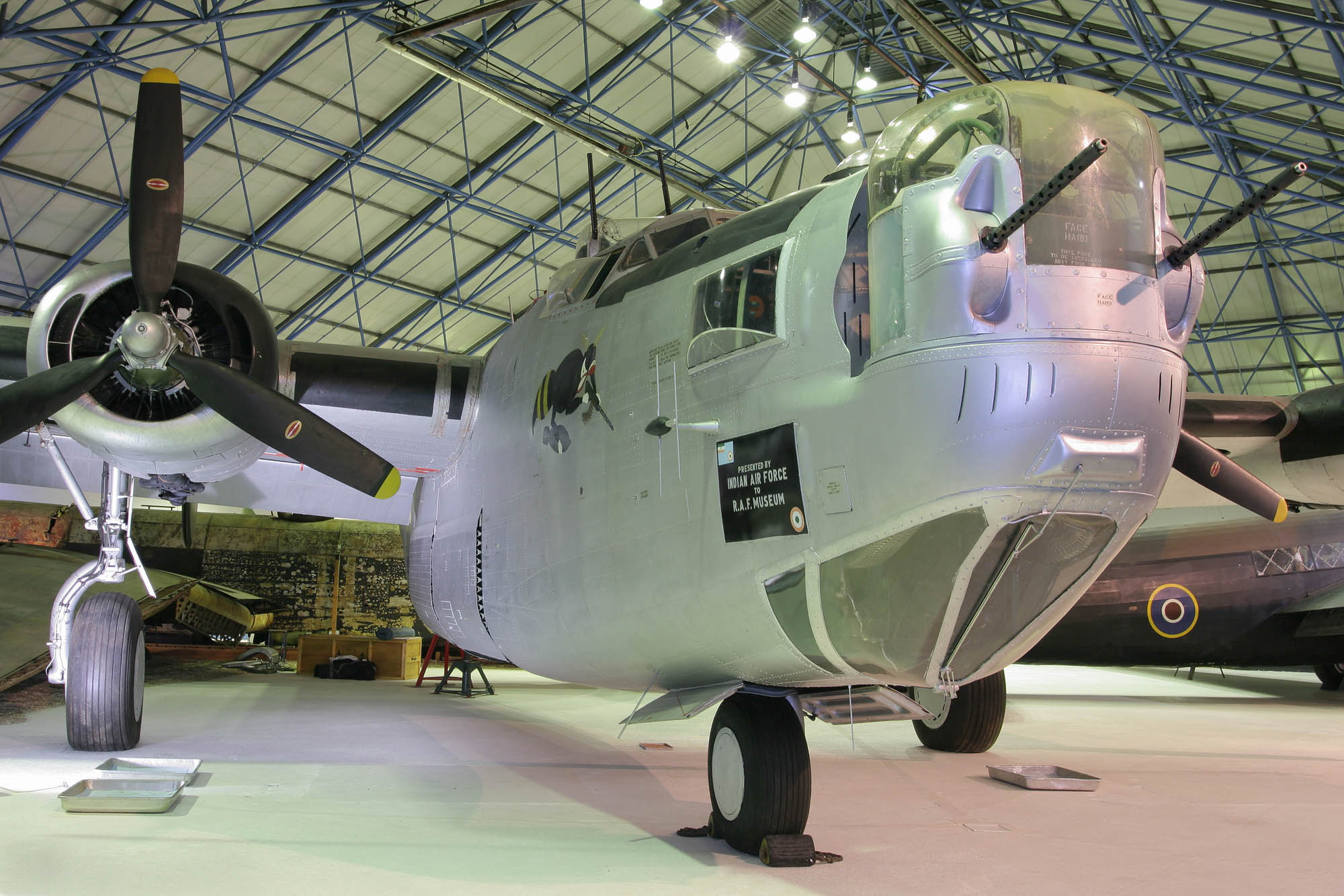 |
Liberator VI (KN751) carries an inscription on the nose stating that the aircraft was
donated by the Indian Air Force to the RAF Museum.
This image is a good example of the excellent use of lighting which includes concealed spotlights under and around the aircraft. |
| January 1989 (Scanned film) |
| Hawker Sea Fury FB.11 (VX653 registered G-BUCM in 1992). |
Left to right:
Hawker Sea Fury FB.11 (VX653). Built in 1949 and delivered to 736 Squadron at RNAS Culdrose. After a period of repairs and storage it arrived at RNAS Lossiemouth in the 1960s. Moved to RAF Museum, Hendon from 1972 to 1991. After which it was sold to The Fighter Collection at Duxford for restoration and registered G-BUCM in 1992.
Lockheed Hudson (A16-199). In 1981 it was sold for £16,000 to the RAFM and moved to Hendon.
Supermarine Spitfire F.24 (PK724 later 7288M). From 1961 until 1970 PK724 was gate guardian at RAF Gaydon before it was moved to Hendon. |
Left to right:
Mikoyan-Gurevich MiG-15bs 'Fagot' Lim-2 (01120 ex Polish Air Force). It was transferred for display at Cosford.
de Havilland DH.110 Vampire F.3 (VT812 'N' later 7200M). In 1978 it was transferred to the RAF Museum. In 1997 a full restoration was started at Cardington and completed at Cosford by 2003, prior to its return to Hendon for display. |


